BIOMEDICAL ENGINEERS advancing human health

ALSO INSIDE
» MANDATORY CPD IS COMING
» 2022 AGM DETAILS













» MANDATORY CPD IS COMING
» 2022 AGM DETAILS











Ontario-based engineers are working to improve drug delivery methods to target and control the release of medicine, resulting in fewer side effects and better outcomes for patients
By Adam Sidsworth
Three groundbreaking biomedical engineering projects are pushing the boundaries of innovation on the micro or nano scale to advance stem cell therapy, tissue transplants and the treatment of diabetes.
By Marika Bigongiari
5 Editor’s Note
President’s Message
CEO/Registrar’s Report
Gazette 39 Notice of 2022 Annual General Meeting
43 In Council: Council proceeds with act and regulation changes
AND COMMENTARY
8 News: We’ve gone digital; Mandatory CPD is coming; Electrical safety code gets an update; More women in nuclear
36 Profile: Learning the craft
42 Bulletin Board


PUBLICATIONS STAFF
Editor
Nicole Axworthy
Associate editor
Marika Bigongiari
Associate editor
Adam Sidsworth
Graphic designer
Cindy Reichle
CONNECT WITH US
Manager, communications
Duff McCutcheon
Digital communications coordinator
Michelle Yiu

ADVERTISING SALES
Account executives
Charlene Woron
Leesa Nacht
Engineering Dimensions (ISSN 0227-5147) is published bimonthly by Professional Engineers Ontario and is distributed to all PEO licensed professional engineers.
Engineering Dimensions publishes articles on regulatory business and professional topics of interest to the professional engineer. The magazine’s content does not necessarily reflect the opinion or policy of PEO Council, nor does PEO assume any responsibility for unsolicited manuscripts and art. All material is copyright. Permission to reprint editorial copy or graphics should be requested from the editor.
Engineering Dimensions is a member of Canadian Business Press.
Indexed by the Canadian Business Index and available online in the Canadian Business and Current Affairs Database.
Approximately $5.00 from each membership fee is allocated to Engineering Dimensions and is non-deductible.
EXECUTIVE STAFF
CEO/registrar
Johnny Zuccon, P.Eng., FEC
Vice president, regulatory operations/deputy registrar
Linda Latham, P.Eng.
Vice president, policy and governance
Dan Abrahams, LLB
Vice president, organizational effectiveness
Liz Maier
PEO COUNCIL
Officers
President Christian Bellini, P.Eng., FEC
Past president
Marisa Sterling, P.Eng., FEC
President-elect
Nick Colucci, MBA, P.Eng., FEC
Vice president (elected) Marilyn Spink, P.Eng.
Vice president (appointed) Chantal Chiddle, P.Eng., FEC
Executive Members
Patrick Quinn, PhD, P.Eng., C.Eng, FEC
Scott Schelske, P.Eng., FEC
Councillors Councillors-at-large
Michael Chan, P.Eng., FEC
Leila Notash, PhD, P.Eng., FEC
Patrick Quinn, PhD, P.Eng., C.Eng., FEC
Eastern Region councillors Chantal Chiddle, P.Eng., FEC
Randy Walker, P.Eng., FEC
East Central Region councillor Christopher Chahine, P.Eng.
Northern Region councillors Luc Roberge, P.Eng., FEC
Ramesh Subramanian, PhD, P.Eng., FEC
Western Region councillors Peter Broad, P.Eng., FEC
Susan McFarlane, MSc, PhD, P.Eng.
West Central Region councillors Lisa MacCumber, P.Eng., FEC
James J. Chisholm, P.Eng., FEC
Lieutenant governor-in-council appointees
Arjan Arenja, MBA, P.Eng.
Robert Brunet, P.Eng.
Lorne Cutler, MBA, P.Eng.
Andy Dryland, C.E.T.
Qadira C. Jackson Kouakou, BA, BSW, LLB
Scott Schelske, P.Eng., FEC
Sherlock Sung
PEO mourns the loss of East Central Region Councillor Peter Cushman, P.Eng.
Engineers Canada Directors
Arjan Arenja, MBA, P.Eng.
Danny Chui, P.Eng., FEC
Nancy Hill, P.Eng., LLB, FEC, FCAE
Kelly Reid, P.Eng., IACCM CCMP
Marisa Sterling, P.Eng., FEC
To protect the public, PEO investigates all complaints about unlicensed individuals or companies, and unprofessional, inadequate or incompetent engineers. If you have concerns about the work of an engineer, fill out a Complaint Form found on PEO’s website and email it to complaints@peo.on.ca. If you suspect a person or company is practising engineering without a licence, contact PEO’s enforcement hotline at 800-339-3716, ext. 1444, or by email at
By Nicole Axworthy

It seems 2022 couldn’t have started out more eventful here at PEO. We jumped into the year with the annual Council elections, planning for the launch of the upcoming mandatory continuing professional development program (p. 9), work on Phase 4 of the Governance Roadmap that focuses on the role of PEO chapters and other non-regulatory and non-governance activities (p. 43), and consultations with the provincial government on how the recently passed Working for Workers Act will impact PEO’s licensing and registration practices for internationally trained engineers (p. 7).
And as we step into March, we’re introducing to you Engineering Dimensions’ first all-digital issue (p. 8) and preparing for upcoming springtime events, while also improving the efficiency of our internal teams and departments during a behind-thescenes organizational restructuring.

What all this has in common is a collaboration component—because none of it could happen without the efforts of dedicated volunteers, councillors and staff. Coincidentally, collaboration could also be the motto for biomedical engineering, the theme this issue. It might not be common knowledge that engineering input in the medical field doesn’t just
centre around building the high-tech gadgetry used in modern healthcare. In fact, many professional engineers spend their days collaborating with medical professionals to come up with solutions to health-related obstacles, such as making the delivery of medication more efficient and engineering new blood vessels. It’s a fascinating world of repairing, regenerating and restoring the health of patients. Read more by clicking over to this issue’s feature articles: “Delivery with purpose” (p. 13) and “Thinking small” (p. 28).
Taking the collaboration concept even further, PEO is also in the midst of planning for its 2022 Annual General Meeting (AGM) on April 30. It’s our third-annual fully virtual AGM, and there are a few changes this year, including a pre-registration requirement and new details on member submissions. At this year’s event, you’ll be able to discuss matters of importance to the regulation of engineering and meet PEO’s new president and councillors for the 2022–2023 Council term. Find more details in the AGM notice on page 39. e
Engineers are at the forefront of medical innovation. We explore how chemical and biomedical engineers are researching polymer drug delivery to treat illnesses more effectively. And we feature three innovative projects at the micro and nano level, ranging from more precise cellular imaging for stem cell therapy to a more effective treatment for Type 1 diabetes.
By Christian Bellini, P.Eng., FEC

This is my last message to you before Presidentelect Nick Colucci, P.Eng., FEC, takes office as president, along with the new Council at PEO’s upcoming annual general meeting.
This year has been busy. You may recall that, at the outset, I indicated that my main role would be to continue with work that was underway with a view to bringing significant parts of it to a conclusion. I am pleased to report success, putting the incoming president and Council in a position to tackle new challenges the coming year will bring.
Accomplishments for this year include operationalizing the ongoing 30 by 30 work, including moving ahead with a gender audit study led by the University of Toronto’s Rotman School of Management. With this work well underway, we were able to stand down the 30 by 30 Task Force. We made continued progress on the anti-racism and antidiscrimination work with a new anti-racism and equity code to be considered by Council at its April meeting. We continued work on the action plan approved by Council to address the recommendations from the external regulatory review. And we continue to work on the launch of a mandatory continuing professional development program, based on PEO’s existing voluntary program, to
bring us in line with engineering regulators across the country. On the staff side, an organizational restructuring led by CEO/Registrar Johnny Zuccon, P.Eng., FEC, has transformed our operations.
But perhaps the most significant item is the two-year Governance Roadmap to review all aspects of PEO governance and incorporate changes, which will result in a renewed and modernized governance structure. Governance experts were engaged to facilitate this work, but ultimately decisions to make changes were solely the responsibility of Council. As I have written before, it has been my strong belief that our outdated governance structure has been an impediment to enhancing and modernizing our regulatory work. I am pleased to report that by the end of this Council year, the governance work will be complete. Successes from this project include a renewed focus at the Council level on high-level strategy for our regulatory work, four new governance committees to back up that work and a better-defined boundary between Council’s role as a provider of strategic direction and the operational work led by our CEO/registrar and his staff. Centralizing responsibility for regulatory policy direction at the Council level will address the previous lack of unified direction that resulted from a very siloed and disjointed approach to regulatory policy development. Armed with this new structure, the new Council will be well positioned to tackle the regulatory challenges ahead.
With the passage of the 2021 Working for Workers Act , the Ontario government has given us fresh work and an ambitious timeline for its completion. Among other things, the new legislation potentially eliminates the Canadian experience requirement for many regulated professions and trades, including engineering. It will also require regulators to commit to meeting agreed-upon processing times for applications for licensure. These two items alone represent significant change to our licensing process; however, I am confident that our new Council is now better equipped than ever to tackle these challenges head on.
I would like to take this opportunity to thank you all for the trust you placed in me to lead our Council this year. Although there is still much work to be done, I feel that we have made significant progress toward modernizing as a regulator and increasing our relevance. I’d also like to thank the outgoing Council for its hard work this year, and in particular those councillors who will not be returning. PEO has a strong tradition of Councils that are passionately committed to working on behalf of the people of Ontario to govern the profession and protect their interests. It is that aspect of self-regulation that provided 100 years of regulatory excellence and will lead to our continued success. Happy 100th anniversary, PEO. e
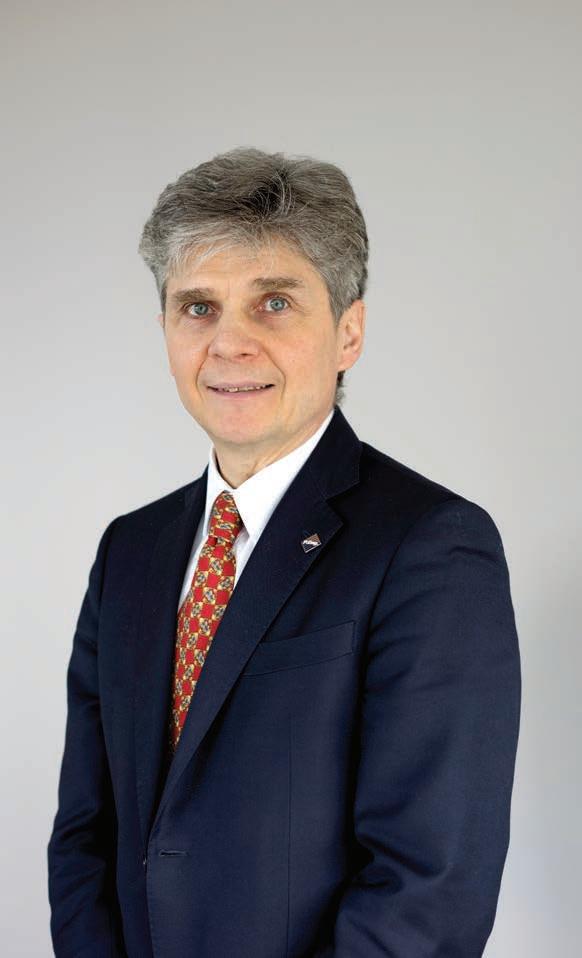
By Johnny Zuccon, P.Eng., FEC
is committed to implementing a mandatory continuing professional development program in early 2023 that is based on the existing voluntary Practice Evaluation and Knowledge (PEAK) program.
Recently, PEO was among several regulatory bodies and compulsory skilled trades that received greater clarity on the provincial government’s expectations with respect to application processes and timeframes. Specifically, the Working for Workers Act (Bill 27), proclaimed on December 2, 2021, included significant amendments to Fair Access to Regulated Professions and Compulsory Trades Act (FARPACTA), to which PEO and many other bodies are accountable. The amendments to FARPACTA will be reflected and more clearly defined in new regulations under that legislation. Although these regulations have yet to be publicized, the changes will significantly impact how regulators implement licensing and registration practices for internationally trained applicants.
In January, PEO was invited to consultations on the proposed FARPACTA regulations. The changes being considered for the new regulations include:
Canadian Experience —Removal of specific requirements for Canadian experience to obtain a licence or provision of alternative requirements that do not include a Canadian experience component. All regulators governed by FARPACTA will be required to fully comply by December 2, 2023.
Decision-Making Timeframes —Reporting on processing and response times, with a requirement that the time to complete individual registration decisions with respect to a complete application is under six months, and that overall time for the complete licensing process is under 12 months. Regulators will be expected to show compliance for up to 90 per cent of all applicants.
mation goal. We’ve committed to a digital transformation journey to enable greater automated processing, deeper business intelligence and overall greater efficiencies, with staff working to improve timelines and advance the digitization of our applications process. We have adopted the National Professional Practice Examination to provide PEO with an objective, psychometrically valid digital professional practice examination. The action plan also called for a longer-term review of some of our academic and admission processes and criteria. These include the existing 12-month Canadian engineering experience requirement for licensure, which forms part of a four-year overall work experience requirement embedded in Regulation 941 under our act. Additionally, PEO
Emergency Plan —Regulators will be required to have a documented emergency plan to ensure continuity of operations and processes to expedite renewals and new registrations in the event of public emergencies that may disrupt normal processes (e.g., another pandemic, natural disaster or threat to public security). Regulators will be required to submit an emergency plan within six months of the date that the regulation comes into effect.
• Language Proficiency Tests —Regulators will be required to accept language proficiency test results that are provided with respect to Immigration, Refugees and Citizenship Canada applications, in addition to any test results that are currently accepted.
Staff are currently drafting a plan to present to our Regulatory Policy and Legislation Committee that addresses the proposed amendments to FARPACTA. Although PEO has a longstanding commitment through the Council-approved action plan to review and enhance our licence application policies and processes, these amendments provide specific change directions and the related timeframes that must now serve as the roadmap to guide our work. e
With PEO’s shift to become a digital organization, all licence holders and engineering interns will now receive Engineering Dimensions via email.
By Adam Sidsworth
This issue of Engineering Dimensions is the first to be delivered to readers solely via email. The magazine’s move to a completely digital delivery— which was announced in late 2021—is part of PEO’s shift towards digital communication with its licence holders, certificate of authorization (C of A) holders and engineering interns (EITs).
Engineering Dimensions has had a digital edition since its January/February 2008 issue, and since then the publication has offered both print and digital versions, with either print or digital being the default delivery method for licence holders and EITs unless they specified a preference. As of the beginning of 2022 and before the switch to digital only, most licence holders and EITs received the digital version of the magazine while less than 20 per cent subscribed to receive the paper copy. Now that the magazine is digital exclusive, all licence holders and EITs who have an email address on file with PEO will receive an email from Engineering Dimensions with a link to the digital edition every time a new issue becomes available.
THE DIGITAL EDITION HAS THE ADDED BENEFIT OF ALLOWING LICENCE HOLDERS AND EITs TO GET THEIR MAGAZINE INSTANTLY; DOWNLOAD A PDF COPY TO THEIR LAPTOPS, SMARTPHONES AND OTHER ELECTRONIC DEVICES; USE KEYWORDS TO SEARCH FOR TOPICS OF INTEREST; AND SHARE CONTENT WITH FRIENDS AND COLLEAGUES.

case management system for various licensing, disciplinary and continuing professional development activities, and it spurred PEO into action. Consequently, PEO is currently undergoing its Information Discovery and Digitization Capability Project to digitalize 21,000 active licence applications (see “PEO undergoes digital transformation of licence application files,” Engineering Dimensions, November/December 2021, p. 8).
PEO remains confident that readers will embrace the digital edition. In addition to having less impact on the environment and saving on production costs—PEO previously spent approximately $200,000 a year to print and mail hard copies of Engineering Dimensions —the digital edition has the added benefit of allowing licence holders and EITs to get their magazine instantly; download a PDF copy to their laptops, smartphones and other electronic devices; use keywords to search for topics of interest; and share content with friends and colleagues. The magazine’s online presence also ensures its content is widely accessible to the public free of charge at anytime. Current and archived issues of Engineering Dimensions are available at engineeringdimensions.ca.
PEO MOVES TO DIGITAL COMMUNICATION
PEO has been moving towards fully embracing digital services and communication platforms since it undertook a 2019 external regulatory review. That review recommended that “PEO should commission a full digital strategy for the organization.” This recommendation was written specifically so that PEO would develop a more secure electronic
The COVID-19 pandemic also necessitated PEO’s shift to an increasingly online environment. Over the past two years, PEO has held its Council, committee and annual general meetings on various digital meeting platforms, effectively democratizing the attendance to PEO events for people across Ontario’s large geography. Additionally, the initial COVID-19 lockdown in March 2020 propelled PEO to hasten its switch from the paper-based Professional Practice Exam to the digitally written National Professional Practice Exam as part of PEO’s licensing application process.
PEO is further expanding its digital mark by requiring all licence holders and EITs to provide a current and unique email address by April 30, 2022, so they can receive communications electronically, including licence renewal notices, Council election materials, annual general meeting updates and continuing professional development information.
PEO’s current voluntary continuing professional development program will transition to a new mandatory program for licence holders, starting in January 2023.
By Adam Sidsworth
PEO’s current Practice Evaluation and Knowledge (PEAK) program, an optional continuing professional development (CPD) program for licence holders, is transitioning to a mandatory CPD program. Starting in January 2023, all PEO licence holders (both practising and non-practising) will be required to comply with the program.
PEO will roll out the transition plan for the mandatory CPD program throughout 2022. During its development, staff will, among other things, update PEO’s website and licence holder portal to facilitate the participation of its 86,000 licence holders. Additionally, PEO is working with the provincial government to update the necessary regulations in the Professional Engineers Act to support a mandatory program and make it enforceable. The regulation changes will enable PEO to, among other things, specify the annual mandatory CPD requirements and levy sanctions against licence holders who don’t complete them.
PEO launched its voluntary PEAK program in March 2017 and has received ongoing feedback from stakeholders during its five years of existence. The feedback will be considered as PEO designs and implements the incoming mandatory CPD program, along with feedback from any additional consultations the program requires. “Consultations will likely serve to gather additional stakeholder concerns, bolster buy-in into the design of the program and offer a pre-education opportunity for stakeholders to learn about some program design considerations,” notes Arden Heerah, P.Eng., PEO’s lead, professional development.
The mandatory program will retain the same guiding principles and program elements of the existing voluntary PEAK program. “PEO is designing the mandatory program to be based on PEAK and its unique features: All licence holders will self-declare their practice status and complete a refresher module on professional practice and ethics each year,” Heerah explains. “However, practising licence holders will additionally receive personalized CPD recommendations corresponding to their professional practice risks established by an annual self-administered practice assessment.”
Heerah also notes that PEO is exploring upgrades for the mandatory program such as improving the user experience, establishing a practicable set of timelines and due dates, offering a range of remedial opportunities and setting reasonable sanctions for non-compliance.
THE MANDATORY PROGRAM WILL RETAIN THE GUIDING PRINCIPLES AND PROGRAM ELEMENTS OF THE EXISTING VOLUNTARY PEAK PROGRAM.
There have long been calls for PEO to introduce mandatory CPD. Since July 2021, PEO has been the lone provincial or territorial engineering regulator in Canada that doesn’t require its licence holders to complete a yearly CPD program. Added to that, investigations at the provincial level have called for PEO to introduce a compulsory CPD program. Notably, the coroner’s inquest into the fatal temporary stage collapse in Toronto, ON, just hours before a concert by rock band Radiohead called for mandatory CPD, as did the Elliot Lake Commission of Inquiry into the fatal roof collapse of the Algo Centre Mall in Elliot Lake, ON. Both collapses occurred just seven days apart in June 2012. Additionally, the external review of PEO’s performance as Ontario’s engineering regulator recommended in 2019 that PEAK be “proportionate and outcome focused and achievable by licensed engineers. It should then make participation in this continuing professional development program mandatory for licensed engineers.”
In February 2021, PEO Council approved a motion that allows PEO to move forward with the creation and implementation of a mandatory CPD program without the need for a member referendum. PEO will make further announcements to licence holders in the coming months as it finalizes the transition to the mandatory program. For up-to-date announcements, go to www.peopeak.ca.
The Electrical Safety Authority has updated the national electrical safety code with specific amendments for Ontario.
By Adam Sidsworth
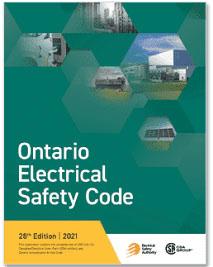
As part of its mandate to regulate electrical safety in Ontario, the Electrical Safety Authority (ESA) has announced the 2021 Ontario Electrical Safety Code (OESC), which will take effect on May 5.
The OESC is comprised of Part 1 of the Canadian Electrical Code (CEC), which was updated by the Canadian Standards Association in January 2021; and Ontario-specific amendments. The updated CEC, together with the Ontariospecific amendments, were subsequently adopted into regulations by the provincial government in the fall of 2021 after an ESA-led consultation process with industry and other stakeholders.
“One of the main highlights this time around is the updated requirement in section 64 [of the OESC] for energy storage systems,” explains Nansy Hanna, P.Eng., senior director, engineering, at ESA. Under the updated OESC, new elaborate electrical safety installation requirements for energy storage systems (ESS) are provided that harmonize with other codes and standards. “Some people in this industry have questions and concerns if these requirements could derail the deployment of ESS,” Hanna admits. “We are reviewing these new requirements and will be publishing a bulletin to consider deviations if conditions are met.”
In Ontario, electric power generating equipment or energy storage systems with a rating in excess of 10 kilowatts and operating in parallel with a supply authority system must be submitted for a plan review by the ESA. However, Hanna notes that the plan review acts as an additional compliance tool for engineers: “The good thing about the plan review process is that if there is anything you’ve missed related to compliance with the OESC, the process helps engineers by flagging these issues early on in the design phase.”
Another OESC update that will potentially affect professional engineers are amendments to section 22, which deal with electrical equipment in buildings that house livestock. The purpose of the new requirements is to reduce the potential for fires and the loss of animals. Citing statistics from the Ontario Fire Marshal and Emergency Management, Hanna notes there are approximately 80 barn fires in Ontario each year involving livestock, with $18.5 million in damage; and 40 per cent of those fires are caused by faulty electrical systems. “Of the main changes, all buildings that house livestock are going to be considered as a Category 1, which is a wet location; and Category 2, which is a corrosive environment,” Hanna reports. “You will be required to design a farm building housing livestock based on that environment—wet and corrosive. All of the equipment inside will have to meet this new requirement. There was a lot of research done in existing buildings housing livestock and the impact of the corrosive environment on the electrical systems. Based on this new code requirement, you are to design based on these categories.”
Section 18 of the OESC, which deals with the installation of electrical equipment in hazardous locations, is also seeing some updates. “I know a lot of
engineers look at this section and design based on it,” Hanna says. “In section 18, one of the main changes coming is the clarifying of sealing requirements. Section 18 had a working group to look at the flow charts and determine when and what type of seal is required. I know this is one of the confusing issues of section 18. The new flow charts will clarify the requirements.”
And in a nod to climate change, the OESC has introduced guidance for electrical installations in flood hazard zones and when electrical equipment has been exposed to water to mitigate the potential risks. “There will be new definitions of flood hazard zones and flood elevation,” Hanna reports. “There are new definitions coming regarding a flood. And then there will be requirements that branch circuits below grade in flood hazard areas will require ground fault circuit protection. The receptacle feeding sump pump will be required to be above the flood elevation level to ensure the pumps will continue to work.”
“ONE OF THE MAIN HIGHLIGHTS THIS TIME AROUND IS THE UPDATED REQUIREMENT IN SECTION 64 [OF THE OESC] FOR ENERGY STORAGE SYSTEMS.
And, notably, ground fault circuit interrupter (GFCI) protection will be required for all outdoor receptacles to mitigate the potential for electrical shock hazard. “All receptacles that are outdoors within 2.5 metres from grade are now required to be protected by a Class A GFCI,” Hanna says. “In the past this requirement was only for residential installations, but new rules will require that all outdoor receptacles located within 2.5 metres of a finished grade are to be protected by a Class A GFCI. This will impact commercial buildings, public parks and recreational outdoor sports fields.”
The ESA regulates and promotes electricity safety in Ontario. It administers part VIII of the Electricity Act and oversees four related regulations, including the licensing of electrical contactors and master electricians, the Electrical Distribution Safety Regulation, the Product Safety Regulation and the OESC, which the ESA helps the province update every three years. The 2021 OESC is available on the ESA website.
Bruce Power and Ontario Tech University aim to attract women to the nuclear energy sector with new internships for first-year nuclear engineering students.
By Marika Bigongiari

Bruce Power and Ontario Tech University are partnering on an internship program designed to encourage women to pursue post-secondary engineering degrees and careers in the burgeoning nuclear sector. Starting this summer, up to 15 first-year students in Ontario Tech’s nuclear engineering program who identify as women will begin the four-month-long internship opportunities at Bruce Power in Kincardine, ON, as part of the Bruce Power Women in Nuclear Engineering Internship Program. The internships are open to both domestic and international students, and those chosen will participate in the program for three consecutive summers with an opportunity for a full-year internship between the third and fourth school years.
Currently, Ontario Tech’s undergraduate nuclear engineering degree program is the only such program offered in Canada, which, together with the Bruce Power internships, invested parties hope will lead to more women working in the industry. According to Electricity Human Resources Canada (EHRC)— a non-profit organization that supports the Canadian electricity and renewable energy sector—women represent approximately one quarter of the electricity and renewable energy workforce. This number falls significantly short of the 48 per cent national average of women working in the Canadian workforce, something the EHRC highlighted in a 2017 report. The report also revealed that women engineers represent just 18 per cent of workers in the electricity sector.
Bruce Power’s partnership with Ontario Tech advances the university’s commitment to increasing diversity while providing valuable work experience to students pursuing careers in nuclear engineering. “Ontario Tech University thanks Bruce Power for this internship opportunity for women engineering students interested in the energy sector, and for helping the engineering profession reach its 30 by 30 goal to raise the percentage of newly licensed engineers who are women to 30 per cent by the year 2030,” says Hossam Kishawy, PhD, P.Eng., dean, faculty of energy systems and nuclear science at Ontario Tech University. “These new internships will drive new hands-on learning and mentorship opportunities for our students that will guide them in their transition to exciting and promising nuclear energy careers.”
The Bruce Power internship program will help create a diversified talent source and make women nuclear engineering students and graduates potential hires for the energy company. “Bruce Power has partnered with a number of organizations to build a pipeline of diverse talent in various roles across the company,” says Cathy Sprague, executive vice president of human resources at Bruce Power.
“This internship program is one of the ways we are building a more diverse and inclusive workforce as part of our clean energy future.”
“THIS INTERNSHIP PROGRAM IS ONE OF THE WAYS WE ARE BUILDING A MORE DIVERSE AND INCLUSIVE WORKFORCE AS PART OF OUR CLEAN ENERGY FUTURE.
In addition to the hands-on internship component, Ontario Tech’s nuclear engineering program introduces students to all aspects of nuclear fuel, from plant operation to waste management, and its curriculum is accredited by the Canadian Engineering Accreditation Board (CEAB), meaning the engineering component of the program can count towards licensure. The CEAB accredits undergraduate engineering programs, which provide the academic requirements for licensure as a professional engineer in Canada. Specifically, a P.Eng. applicant who holds an undergraduate degree in an engineering program accredited by the CEAB will meet the first step of PEO’s academic requirement.
The new internships are timely considering how vital nuclear power has become to Ontario’s energy future. Nuclear power accounts for approximately 60 per cent of the province’s power needs. It’s a growing industry, with a multitude of opportunities on the horizon, including major refurbishment projects to ensure plants function for decades; small modular reactors to support reliable power generation in remote communities; and isotope capturing from Ontario nuclear facilities.
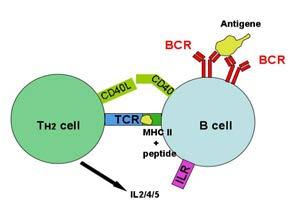
Researchers at Ohio State University have discovered a method of increasing the activation of T cells inside cancerous tumors, improving the effectiveness of their interaction with a novel antibody therapy.
The researchers developed nanoparticles from a compound present in cell membranes and used them to deliver mRNA—developed to carry instructions for molecules that are normally produced by T cells as part of the immune response—directly into cells.
University of Waterloo chemical engineering professor Marc Aucoin, PhD, P.Eng., is part of a multidisciplinary team working to develop a DNAbased vaccine for COVID-19. The vaccine will be delivered using a nasal spray that will serve as a therapeutic, as well as stimulating the body to build immunity to COVID-19. It works by using engineered bacteriophage, a process that will allow the vaccine to stimulate an immune response in the nasal cavity and target tissues in the lower respiratory tract.
Photo: Alexey Solodovnikov


Most drugs are taken orally, but it’s an inefficient way of delivering medicine. Ontario’s leading engineer researchers are working to create alternative smart drug delivery methods using polymers that target and control release, resulting in better outcomes for patients.
— BY ADAM SIDSWORTH —
People know the word, yet they find it difficult to pin down its traits in a person. According to the Schizophrenia Society of Canada, symptoms are wide ranging—delusions, hallucinations and disorganized speech and behaviour, along with a reduction in motivation, emotional flatness and an inability to start and follow through with actions. A diagnosis is not easy, as healthcare workers must rule out sustained mood disorders, the effects of substance abuse and pervasive developmental disorders such as autism.
The exact cause of schizophrenia isn’t entirely known, but one thing is: The structure and chemistry of the brain of people with schizophrenia is different from that of the general population. Some suspected causes for the structural differences may be viral infections or difficult births. Since the 1950s, antipsychotic or neuroleptic medication has been used to treat schizophrenia, and with it came horrible side effects—restless motion; the stiffness, dry mouth and sedation typical of Parkinson’s disease; and tardive dyskinesia (repetitive movements of the face or torso). The second generation of antipsychotic drugs reduced these side effects, but they still have side effects of their own—weight gain, diabetes or cardiac disease. People can also become agitated and wired, unable to stop; while others become sedated and extremely tired.
Many of the drugs used to combat the schizophrenic symptoms—Asenapine, Aripiprazole, Iloperidone are examples—are typically taken orally or by injection, at which point they must go throughout the body’s acidic digestive system, be broken down and disperse throughout the body to reach the brain through blood. And because the brain is protected by the blood-brain barrier, people with schizophrenia have to take more medication than is necessary to treat the actual symptoms. Some medical professionals have theorized that
if a more direct delivery were available, perhaps the drug could be delivered at a lower dosage—thus reducing such severe side effects. And that is where the research on polymer drug delivery by Ontario’s engineers and other professionals come into play.
“The basis of my research is on hydrogels,” explains Todd Hoare, PhD, P.Eng., professor of chemical engineering at McMaster University, where he leads the Hoare Lab for Engineered Smart Materials. “They are similar to things like soft contact lenses or Jell-o or the stuff in diapers. They are hydrated polymer networks.”
Hydrogels are three-dimensional networks of hydrophilic polymers that can swell in water and hold a lot of water while maintaining their structure due to chemical or physical crosslinking of polymer chains. Polymers are materials made from long repeating chains of molecules. And although the term “polymer” is often used to refer to synthetic products like plastics, polymers can also be naturally occurring—think rubber and wood. Proteins are naturally occurring polymers of amino acids, and DNA is a polymer of nucleotides.
“There are two types of hydrogels we work on in drug delivery,” Hoare explains. “The first is in situ-gelling hydrogels—materials that gel rapidly upon mixing, a hydrogel version of epoxy glue. The reason we are interested in these is that it allows us to get gels inside the body with just an injection without having to implant them, which is a huge translational barrier to get a lot of these things in practical use.”
The second type of hydrogels Hoare explores is called microgels. “These are also hydrogels but are very, very small gel particles on the nanoscale,” Hoare says. “We are particularly interested in microgels that respond to temperature, pH, magnetic fields or the reductive environment inside the body. If there are a lot of bacteria present or a rapidly growing cancerous tumour producing heat or a lot of acid, we can take advantage of those local environmental differences to make the microgels swell or shrink or degrade at the site in the body we want the drug delivered to.”
The versatility of hydrogels is what makes them an attractive delivery vehicle to get drugs into the body without involving the digestion system. “There’s been quite a bit of research on nanoparticle delivery for many years,” Hoare explains. “But usually, the particles circulate throughout the body and release the drug throughout the body as well. There’s nothing specific that says, ‘Here is the disease. Now here is where I need the drug to go.’ If we can design microgels to move drugs to the targeted site, we can lose less drug overall and less drug [to] everywhere in the body.”
This discovery led to Hoare’s research with Ram Mishra, PhD, professor at McMaster’s department of psychiatry and behavioural neurosciences and co-director of the McMaster School of Biomedical Engineering. Mishra realized that for maximum dosage with less side
Photo: NSERC
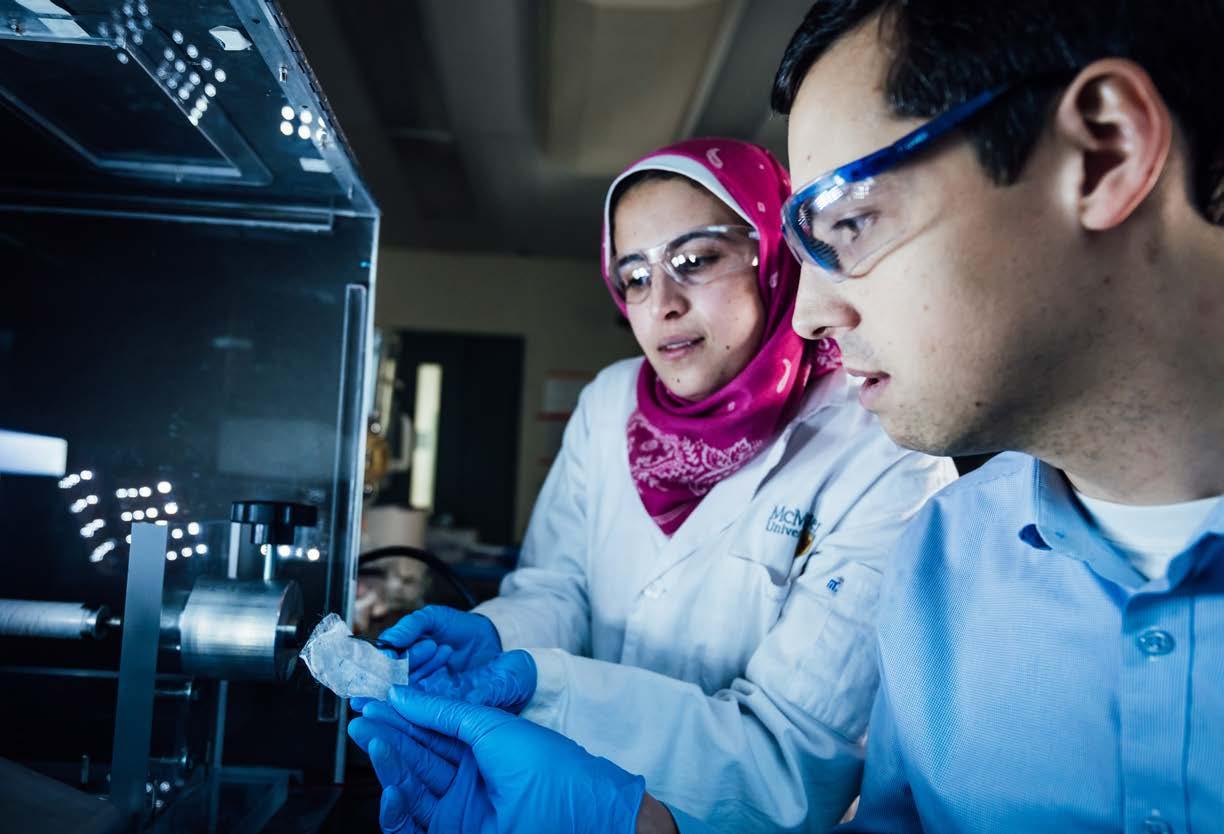
effects, he should be delivering a schizophrenic drug directly to the brain as a nasal spray through the olfactory nerve in the nose.
“The trick here is to administer the drug through the back door to the brain, since the front door is sealed so tightly,” Mishra said in a McMaster University press release. “This way we can bypass the blood-brain barrier. By delivering the drug directly to the target, we can avoid side effects below the brain.” Mishra had co-created a water-soluble schizophrenic drug, PAOPA, with Rodney Johnson, PhD, distinguished professor emeritus of medicinal chemistry at the University of Minnesota, but they lacked an efficient delivery system, since drugs delivered via the nose are typically cleared from the body quickly.
And this is where Hoare’s research stepped in. Hoare had been previously working on nanoparticles of cornstarch for agricultural applications. He readjusted his research and found that when cornstarch nanoparticles are sprayed with a naturally occurring polymer derived from crabs, the drug could penetrate deep into the nasal cavity, form a thin gel in the mucus lining of the nose and slowly release the drug in controlled doses to control symptoms of schizophrenia for three days.
“It’s an entirely new set of properties you have to consider going through the nose,” Hoare observes. “An orally administered drug needs to be compressible into a pill or capsule that can be swallowed, stabilized in the stomach and then released in the intestine
“BY DELIVERING THE DRUG DIRECTLY TO THE TARGET, WE CAN AVOID SIDE EFFECTS BELOW THE BRAIN.
to get through all the barriers of the gut. You have to lubricate it to swallow it and get it out of the digestive tract,” a highly acidic environment. “Whereas with the sprayable formulation, we need to ask questions like, ‘How much force can you apply to administer a dose?’ And a lot of patients are elderly. How much pressure can they apply? How do we make sure the formulation sticks to the nose and gels at the right time so that we don’t waste the drug and get a good effect? There’s a lot of engineering work that goes into adjusting the material. We look at the structure, property and how we design the polymer. What properties do we get? How are they relevant to the application?”
Hoare notes that the drug delivery system has so far been tested on rats with induced schizophrenic symptoms such as social withdrawal. Hoare and Mishra are seeing good results and are preparing to go to the next step of testing the drug on larger animals, with Hoare even tweaking the delivery to explore an effective drug delivery for Parkinson’s disease and bipolar disorder. “The [existing] Parkinson’s drug is really unstable,” Hoare observes. “We’ve added some chemistry to our delivery vehicle to stabilize it to get an extended delivery.”
MANY OF THE POLYMER DELIVERY SYSTEMS HE IS EXPLORING COULD BE SEEN AS LESSENING THE INVASIVE NATURE OF SURGERY OR REDUCING THE NEED FOR IT ALTOGETHER.
Brian Amsden, PhD, P.Eng., professor, Donald and Joan McGeachy chair in biomedical engineering at Queen’s University, is also exploring the diverse roles polymers can play in drug delivery and surgery. Recognizing that no one polymer will suffice as a delivery for all drugs and illnesses, Amsden’s research focuses on the use of biodegradable and biocompatible polymers to design drug delivery approaches for therapeutic angiogenesis and treating ocular conditions such as optic neuropathy. Many of the polymer delivery systems he is exploring could be seen as lessening the invasive nature of surgery or reducing the need for it altogether.
Amsden’s largest success has been with therapeutic angiogenesis, used to treat ischemia. Ischemia can result in low oxygen concentration as a result of blockages in the arteries. This often manifests in peripheral arterial disease (PAD)—blockage of blood and oxygen
to the lower limbs. For PAD, which usually results from a buildup of fatty deposits in the arteries, the biggest symptom can be claudication—cramping in the hips from activities like walking or climbing stairs, leg numbness, coldness in the lower feet, sore toes and feet and a weak or even a lack of a pulse in your feet. “[Patients] may end up with a cut on their foot they don’t even know they have,” Amsden observes. “Or it may end up getting gangrenous, at which point, surgery is not an option.” Limb amputation is often the solution.
“What we’re trying to do is treat these blockages by inducing the body to grow blood vessels around the blockage to feed the tissue,” Amsden explains. “We’re designing drug delivery systems for implantation that release what are called proangiogenic drugs that cause new blood vessels to form to guide them around the blockages.”
Although Amsden has seen success with this in animal models, he says he is still a long time away from delivering a polymer drug delivery to the clinic. “There’s a long way between getting something working in animals and clinical,” Amsden observes. “Particularly if you’re developing new polymers and applications, you have to demonstrate safety in the material and the device before you can move into humans. That takes a fair bit of work.”
Indeed, Amsden’s approaches are novel, with some of his polymer delivery systems being stimuli responsive, meaning they are drug-release devices that remain intact until acted on by a stimulus. Take the case of the polymer delivery that Amsden is developing for treating optic neuropathy, a condition when swelling damages the neurons in the retina that transmit visual signals to the brain. Damage to these neurons can be a result of glaucoma, inflammation, infection, trauma or the presence of a tumour. A promising effective treatment involves delivering neurotrophic factors to the back of the eye; unfortunately, the conventional drug administration is to give the patient multiple intraocular injections.
“The challenge of that is injecting people in the eye. It’s not a great thing to do,” Amsden says. “A great many patients don’t want it. And there’s a limit to how many times you can inject somebody in the eye. What we have designed is a polymer system that remains intact to provide

Brian Amsden, PhD, P.Eng., is working on multiple polymer delivery systems, including one that is released by light stimulus to treat optic neuropathy, a disease that affects the neurons in the retina of the eye.
predictable release rates of the drug until acted upon by light of a given wavelength. You need to have a certain amount of energy applied to it. When the light reaches it, the polymer is caused to break down, so it degrades over a period of a couple of days. The idea is that you have a predictable release, and once it’s done, the [doctors] go in with a laser and cause the delivery system to break apart. That’s a stimulus release.”
Although polymer delivery devices can theoretically improve the administration of drugs into the body, the majority of drugs are still delivered orally via tablet or capsule. And Amsden recognizes why the pharmaceutical and medical professions navigate towards oral delivery, despite its drawbacks: “Patient compliance is huge, so it’s far easier for people to take a tablet. Even if you do it in a social setting, nobody’s going to question that you take out an aspirin. But in order for that drug to be effective, it needs to get into the bloodstream. Taken orally, it goes into the digestive system, which is an acidic environment with lots of enzymes. Your gastrointestinal system is meant to absorb small molecules and break food down. The likelihood of all the drug being absorbed into the bloodstream is pretty low. And once absorbed, it gets distributed throughout the body. That’s where you end up with possible side effects.”
Polymer delivery remains a popular research area for engineering and medical professionals from across Canada, involving multidisciplinary teams of experts in disciplines that include physics, chemistry, biology and engineering. Yet there is lack of a co-ordinated effort to ensure an expansive, multiscale approach to research in this area. However, universities across Canada—including Ontario—are now co-ordinating the work of their researchers as part of the polymer
nanoparticles for drug delivery multi-institutional research program organized by the University of Victoria, including training modules and capstone courses, interdisciplinary research, industrial internships and research days. With this in mind, polymer research may indeed be at the forefront of drug delivery research in Canada. e
On allegations of professional misconduct under the Professional Engineers Act (act) regarding the conduct of RICHARD N.A. SAWYER, P.ENG. (Sawyer), a member of the Association of Professional Engineers of Ontario.
A panel of the Discipline Committee of Professional Engineers Ontario (PEO) heard this matter remotely on October 13, 2021, via Zoom. The parties submitted an Agreed Statement of Facts (ASF) and a Joint Submission on Penalty (JSP).
Sawyer was the principal of Sawyer Duncan Engineering Ltd. (SDEL). SDEL’s certificate of authorization (C of A) lapsed due to non-payment of fees. PEO wrote to Sawyer and SDEL multiple times requiring SDEL to amend its corporate name to remove the word “engineering” in light of the lapse of its C of A. SDEL also maintained a website in which it continued to hold itself out as being authorized by PEO, which was no longer the case. The above letters demanded that Sawyer and SDEL obtain a new C of A. Sawyer admitted to stamping drawings for another company and doing part-time work for SDEL clients. He said he would renew his C of A but did not do so until after the scheduling of a hearing by the Discipline Committee regarding this matter.
The complaint in this matter contained the above concerns and Sawyer’s failure to co-operate with PEO.
Sawyer advised PEO that all inquiries received through his website were being referred to another professional engineer with a valid C of A, and that he did some work for a company called Pioneer Steel. PEO informed Sawyer that he required a C of A for the work he was doing with Pioneer Steel. Sawyer advised that he would get a C of A, take down the website, dissolve the company and provide a written response to the complaint.
Despite repeated requests and written cautions, and while acknowledging PEO’s concerns and offering to take remedial action, Sawyer did not take remedial action until after the Discipline Committee hearing was scheduled. At that point, Sawyer applied for a C of A and took down the website.
Sawyer engaged in providing services within the practice of professional engineering and offered to provide such services to the public contrary to section 12(2) of the act, amounting to professional misconduct as per section 72(2)(g) of Regulation 941. Sawyer also failed to co-operate with PEO in a manner that was unprofessional, amounting to professional misconduct as per section 72(2)(j) of Regulation 941.
Sawyer pled guilty to the allegations in the ASF. The panel found that the facts supported the findings of professional misconduct in the ASF and that Sawyer committed those acts.
The panel accepted the penalties in the JSP and so ordered:
a. Pursuant to s. 28(4)(f) of the Professional Engineers Act, the member shall be reprimanded, and the fact of the reprimand shall be permanently recorded on the register;
b. Pursuant to s. 28(4)(i) of the Professional Engineers Act, a summary of the findings and order of the Discipline Committee shall be published, together with the name of the member, in the official publication of PEO; and
c. Pursuant to s. 28(4)(j) of the Professional Engineers Act, the member shall pay costs to PEO in the amount of $2,000.
Warren Turnbull, P.Eng., chair of the discipline panel, signed the Decision and Reasons on November 10, 2021, on behalf of the other panel members: Alisa Chaplick, LLB, and Glenn Richardson, P.Eng.
In the matter of a hearing under the Professional Engineers Act, R.S.O. 1990, c. P.28; and in the matter of a complaint regarding the actions and conduct of FRANCO DiGIOVANNI, LEL, a member of the Association of Professional Engineers of Ontario.
This matter came to a hearing before a panel of the Discipline Committee on November 30, 2021. The matter arose as a result of three separate complaints against Franco DiGiovanni, LEL (the member), and it proceeded via an Agreed Statement of Facts and a Joint Submission on Penalty.
In summary, the Agreed Statement of Facts sets out the following conduct by the member:
• On or about June 13, 2018, the member emailed the company of a professional engineer regarding a disagreement over whether a plan for odour best management practice was required for a particular manufacturer. His email stated: “The discussion I wish to have with [the engineer] is in regards to potential professional malpractice on his part. It would be in his best interest to talk to me first before this proceeds any further.” The member filed a complaint with PEO against the engineer on July 4, 2018; this complaint was not referred to the Discipline Committee.
• On April 23, 2018, the member gave a presentation before a municipal council in which he alleged that the professional planner for an aggregates company had failed to meet her duties as a planner in respect of a proposed gravel pit. He questioned her competence as a planner and suggested that the council initiate a malpractice suit against her. The member later filed a complaint against the planner with the Ontario Professional Planners Institute (OPPI) that was not referred to a disciplinary process.
• On July 16, 2018, the member emailed the planner for the municipality, copying all of the municipal councillors, threatening to file a complaint of professional malpractice against the planner due to his view that the gravel pit development did not require an air quality assessment. The member later filed a complaint against the planner with the OPPI that was not referred to a disciplinary process.
• On April 26, 2019, the member signed a peer review report on an air quality assessment prepared by a professional engineer regarding a proposed quarry. The member wrote in his review that he “would question the competency of [the engineer] to conduct such work.”
• On October 30, 2019, the member gave a presentation at an industry association conference, at which the following events occurred:
o The member stated that “planners can make bad mistakes when they deviate outside their own field.” He referred to the professional planner in the case of the gravel pit development and noted that he had filed a malpractice complaint against her to OPPI. He stated that the non-referral of the complaint was “ludicrous” and that he was investigating the OPPI.
o The member criticized air-quality assessments prepared by two individuals in attendance at the conference, one of whom was a professional engineer. He described their work as incompetent and accused them both of malpractice because they had not completed cumulative effects assessments with respect to two projects.
o The member and the professional engineer in attendance exchanged words. The professional engineer made an obscene gesture towards the member, to which the member responded from the stage with a different obscene gesture. As the member left the stage, he referred to the engineer with a vulgar and misogynistic obscenity that was overheard by other attendees.
• On January 22, 2020, the member gave a presentation at a public meeting hosted by a community advocacy group. The presentation was recorded and posted to social media. The member made allegations of inappropriate conduct on the part of a professional engineer in respect of a proposed quarry. The member stated in respect of the professionals involved in the project: “So it kind of calls in question even the competence or the honesty of the people involved. I don’t know which, but there is something not right there.”
• The member facilitated or filed eight separate complaints against professionals involved in environmental planning, none of which have been referred to disciplinary processes.
The member admitted to the following misconduct:
1. Conduct that, having regard to all the circumstances, would reasonably be regarded by the engineering profession as disgraceful, dishonourable or unprofessional, amounting to professional misconduct as defined by section 72(2)(j) of Regulation 941 under the Professional Engineers Act (the act); and
2. Harassment as against three professional engineers, amounting to professional misconduct as defined by section 72(2)(n) of Regulation 941.
The panel accepted that the member’s conduct was clearly disgraceful, dishonourable and unprofessional, in particular:
• Impugning without reasonable basis the competence, honesty, motives and integrity of other regulated professionals, both in writing and in public forums, on multiple occasions;
• Making intemperate and inappropriate remarks with respect to other regulated professionals, and threatening or suggesting that legal or regulatory action should be taken against them;
• Filing vexatious or retaliatory complaints against other regulated professionals who had expressed concerns regarding his behaviour; and
• Using an obscene hand gesture and a vulgar and misogynistic obscenity to refer to a professional colleague in a public forum.
Likewise, the panel accepted that the member’s conduct with respect to certain complainants amounted to harassment as defined in the regulations.
The panel accepted a Joint Submission on Penalty and issued the following order:
1. Pursuant to s. 28(4)(f) of the act, the member was reprimanded immediately following the hearing, and the fact of the reprimand shall be recorded on the register permanently;
2. Pursuant to s. 28(4)(b) of the act, the member’s licence shall be suspended for a period of three (3) months, commencing immediately following the hearing;
3. Pursuant to sections 28(4)(i) and 28(5) of the act, the finding and order of the Discipline Committee shall be published in summary form in PEO’s official publication, with reference to names;
4. Pursuant to s. 28(4)(d) of the act, it shall be a term or condition on the member’s licence that he shall, within eighteen (18) months of the date of the Discipline Committee’s order, successfully complete the National Professional Practice Examination (NPPE); and 5. There shall be no order as to costs.
The panel noted that the member’s conduct was not in keeping with the expectations of civility and professional courtesy applicable to members of the profession and that instances of professional disagreement must be expressed in a respectful, ethical and reasonable manner. It felt that the member’s actions warranted strong condemnation and that the penalty achieved that goal.
The panel was satisfied that the penalty served the purposes of general and specific deterrence, rehabilitation and maintenance of the public’s confidence in the regulation of the profession. The panel was reassured by several mitigating factors, including the member’s submission of a letter of apology addressed to the relevant complainants, and his acceptance of responsibility for his actions through the Agreed Statement of Facts and Joint Submission on Penalty. The panel also felt that the requirement to complete the NPPE would assist the member’s rehabilitation and support his commitment to professional practice in future.
Robert Willson, P.Eng., chair of the discipline panel, signed the Decision and Reasons on December 13, 2021, on behalf of the other panel members: Eric Bruce, JD, and Brian Ross, P.Eng.
In the matter of a complaint regarding the actions and conduct of a member of the Association of Professional Engineers of Ontario and a holder of a certificate of authorization.
1. The complaint relates to work done by the member and holder to complete and submit Records of Site Condition (RSCs) for two properties located in Toronto, ON, to the then Ministry of the Environment and Climate Change, currently Ministry of the Environment, Conservation and Parks (collectively “the ministry”).
2. At all material times, the holder held a certificate of authorization (C of A) naming the member as the individual accepting professional responsibility for engineering services provided under the C of A.
3. The member and holder did not have a written contract or agreement with the client to complete the work for the two properties.
4. In an email dated April 25, 2017, the member informed the client that the work required for the properties would be completed within six months or more.
5. In an email dated December 7, 2017, the member informed the client that the RSCs for the properties would be filed on Friday (December 8, 2017). Consequently, in an email dated December 9, 2017, the client requested that the invoice for the work be submitted before the end of 2017.
6. In an email dated December 11, 2017, the member issued an invoice to the client and stated that the RSCs for the properties had been filed and that the client would receive notification from the ministry within five working days.
7. However, it was later discovered that the RSCs for the properties had not been filed as communicated by the member.
8. Once discovered, the member submitted an RSC for each property; however, in emails
dated May 28, 2018, and June 15, 2018, the client received a Notification of “Not in Accordance” (NIA) for each RSC from the ministry. The ministry provided its reasons for the NIAs including that the submissions were missing data, contained inconsistencies, did not meet the necessary requirements and were not completed in accordance with the regulations.
9. Following the NIAs, the member and holder resubmitted the RSCs, and subsequently the member’s client received additional NIAs from the ministry for each property. Sometime after this, the member and holder ceased work on the properties for the client.
10. The complaint raised issues concerning the work completed by the member and holder with regards to their having submitted an invoice for work that had not yet been completed.
11. The Complaints Committee (the committee) received a candid and fulsome response to the complaint from the member and holder, including an explanation relating to the member and holder’s scope of work on the project. The member also expressed that it is not the holder’s policy to invoice for work that is not complete.
12. The committee considered the complaint five times between July 9, 2019, and July 15, 2020. The committee considered the response received and carefully considered the issues raised in this matter. In addition to the invoicing concern, the committee was concerned that the member and holder did not keep copies of the relevant versions of the Phase II ESA reports referenced by each RSC submission. The committee considered whether a referral to the Discipline Committee was warranted in all the circumstances, and whether it was in the interest of the public and the profession to proceed with the matter. The committee decided that if the issues raised in the complaint were addressed through certain proactive remedial efforts on the part of the member and holder, as well as publication of a summary of this matter, that the public interest issues raised by the complaint would be addressed.
13. The member and holder voluntarily undertook to:
a. Complete a written contract or agreement for every client, clearly documenting the scope of engineering services to be completed with reasonable timelines.
b. Not submit final invoices stating that work has been filed and/or completed when the work is not yet completed.
c. Respond in a timely manner to queries by a client in relation to services retained.
d. Prepare a Corporate Policy Manual with particular focus on version control of documents and record keeping and to provide a copy of the policy manual to PEO.
14. Further, the member and holder voluntarily agreed that a summary of this matter and the voluntary undertaking would be published in PEO’s Gazette without their names.
15. The voluntary undertakings described above were completed and accepted by the committee as a dispositive measure, and pursuant to its powers under section 24(2)(c) of the act, the committee decided that this matter would not be referred to the Discipline Committee.
In the matter of a complaint regarding the actions and conduct of Ludmila (Lucy) Shaw, P.Eng., a member of the Association of Professional Engineers of Ontario, and LKS Consulting Inc., a holder of a certificate of authorization.
1. The complaint relates to work done by Ludmila (Lucy) Shaw (Shaw) and LKS Consulting Inc. (LKS) in relation to an as-built survey for a single-family dwelling (SFD), located in Toronto.
2. At all material times, LKS held a certificate of authorization (C of A), and Shaw was named as the individual accepting professional responsibility for engineering services provided under the C of A.
3. In or about September 2016, a contractor commenced construction of the SFD, and during the construction process, the contractor and related parties were advised that the City of Toronto requires an as-built survey to verify the setbacks and finished floor elevation (FFE) for the SFD under construction at the site.
4. In or about February 2017, Toronto Land Surveyors Inc. (TLSI) contacted Shaw. Shaw advised that she could review and seal an as-built survey for the SFD. Shaw did not have a written contract with the homeowners, the contractors or TLSI.
5. On or about March 13, 2017, Shaw issued an LKS invoice dated March 11, 2017, to TLSI, for the as-built survey. The LKS task description stated:
• “Reviewed the ‘as-built’ set-backs as per the proposed designed and approved setbacks, as provided by Toronto Land Surveyors Inc.”
• “Stamped the drawing and provided to Toronto Land Surveyors Inc.”
6. On or about March 15, 2017, the as-built survey with Shaw’s seal and signature was submitted to the city.
7. The City Inspection Report entries dated March 15 and 16, 2017, noted that the as-built survey
showed an encroachment of 0.06m, and an Order to Comply was issued to the owner and contractor.
8. On review of the as-built survey, the city reported the matter to the Association of Ontario Land Surveyors (AOLS). The AOLS subsequently filed an application before the courts claiming that Shaw et al. conducted cadastral survey work without a licence, as required under the Surveyors Act, RSO 1990, c. S.29, s.11. In particular, TLSI prepared an “as built survey” for the SFD, signed and stamped by Shaw, which depicted the boundaries of land.
9. The complaint raised issues concerning the actions of Shaw and LKS with regards to providing a survey showing property boundaries, work that is governed by the Surveyors Act. In addition, it was noted by the Complaints Committee (committee) that there was no record of disclosure of liability in the absence of liability insurance to the client.
10. The committee received a response to the complaint in which the respondents stated that they stamped the verification of the topographic elevation of the slab and verification of the setback. The respondents also stated that they checked the drawings and the grades compared with the Site and Grading Plan dated October 18, 2016, that had been submitted with the building permit application, and that they were unaware that TLSI did not provide cadastral surveying.
11. The committee considered the complaint five times between May 15, 2019, and July 15, 2020. The committee considered the response received and carefully considered the issues raised in this matter. The committee considered whether a referral to the Discipline Committee was warranted in all the circumstances and whether it was in the interest of the public and the profession to proceed with the matter. The committee decided that if the issues raised in the complaint were addressed through certain proactive remedial efforts on the part of the member and holder, as well as publication of a summary of this matter, that the public interest issues raised by the complaint would be addressed.
12. Shaw and LKS voluntarily undertook:
a. To not undertake cadastral survey work governed by the Surveyors Act
b. To complete a written contract or agreement for every client which clearly documents the scope of engineering services to be completed and to document disclosure of liability in the absence of liability insurance.
c. To prepare and submit to PEO a Quality Manual that would include policies and procedures for field reviews, review/ supervision of measurements or inspections by others, appropriate use of seal and retention of engineering documents.
13. Shaw and LKS voluntarily agreed that a summary of this matter and the voluntary undertaking would be published in PEO’s Gazette with reference to their names.
14. The voluntary undertakings described above were completed and accepted by the committee as a dispositive measure and, pursuant to its powers under section 24(2)(c) of the act, the committee decided that this matter would not be referred to the Discipline Committee.
In the matter of a complaint regarding the actions and conduct of a member of the Association of Professional Engineers of Ontario and a holder of a certificate of authorization.
1. The complaint relates to work done by the member and holder in relation to signed commitments for General Review for Mechanical, Electrical and Plumbing relating to a commercial cooking exhaust system.
2. At all material times, the holder held a certificate of authorization (C of A) naming the member as the individual accepting professional responsibility for engineering services provided under the C of A.
3. On or about May 8, 2018, the member submitted a signed and sealed Mechanical Field Review Letter stating that the heating, ventilating and air conditioning (HVAC) system was constructed in general conformity with the approved permit drawings and the 2012 Ontario Building Code requirements. Upon inspection, it was noted that the exit door hardware was not installed as per the approved drawings or in accordance with the Ontario Building Code. The member’s Mechanical Field Review Letter was deemed unsatisfactory, and a resubmission was required.
4. On or about May 29, 2018, the member submitted a second signed and sealed Mechanical Field Review Letter stating that the kitchen exhaust and HVAC system were completed in general conformity with the relevant NFPA-96 standard, the approved permit drawings and the 2012 Ontario Building Code requirements. Upon inspection, several deficiencies were noted, including how the fire wrap insulation for a vent extending through the roof deck was installed. The member was required to resubmit a Mechanical Field Review Letter with revisions.
5. On or about June 21, 2018, the member submitted a third signed and sealed General Review Letter stating that the sprinkler system was in compliance with NFPA-13 requirements
and that the kitchen exhaust was in compliance with NFPA96 requirements and the approved permit drawing and that installation of the emergency lighting system was in compliance with the 2012 Ontario Building Code requirements. Upon inspection, it appeared that the fire wrap was installed correctly. However, deficiencies were noted, including certain duct installation details not installed in accordance with NFPA-96 requirements. The member was required to submit a General Review Letter with further revisions.
6. On or about June 29, 2018, the member submitted a fourth signed and sealed Mechanical Field Review Letter stating that the kitchen exhaust riser through the roof had been installed and was in compliance with NFPA-96 and the 2012 Ontario Building Code requirements. Upon inspection, the previously noted deficiencies were found to have been corrected and the building permit was signed off.
7. The complaint raised issues concerning the work completed by the member and holder with regards to the improper installation of a kitchen exhaust system, the adequacy of the General Review Letters prepared and the deficiencies noted upon inspection.
8. The Complaints Committee (committee) reviewed the member and holder’s detailed response to the complaint.
9. The committee considered the complaint on November 27, 2018, and March 20 and September 11, 2019. The committee considered the response received and carefully considered the issues raised in this matter. The committee considered whether a referral to the Discipline Committee was warranted under the circumstances and whether it was in the interest of the public and the profession to proceed with the matter. The committee concluded that the issues raised in the complaint were in the nature of technical details that were subject to review and approval by a local agency and noted that the member and holder willingly complied with instructions to correct them. Consequently, the committee took the view that the matter could be addressed through certain proactive remedial efforts on the part of the member and holder, as well as publication of a summary of this matter. The committee decided that in this way, the public interest issues raised by the com-
plaint would be adequately addressed, and information about the concerns raised by the complaint would be shared with other practitioners.
10. The member and holder voluntarily undertook to:
a. Within 15 days, review PEO guidelines titled Professional Engineers Providing General Review of Construction as Required by the Ontario Building Code and Use of Professional Engineer’s Seal and provide confirmation to PEO.
b. Within three months, develop a QA/ QC procedure manual and submit it to PEO for review. The member and holder undertook to use this QA/QC procedure manual for all field inspections.
c. Ensure proper communication with clients regarding General Review Services.
11. The member and holder voluntarily agreed that a summary of this matter and the voluntary undertaking would be published in PEO’s Gazette without their names.
12. The voluntary undertakings described above were completed by the member and holder and accepted by the committee as a dispositive measure and, pursuant to its powers under section 24(2)(c) of the act, the committee decided that this matter would not be referred to the Discipline Committee.
The Ontario Court of Justice at Kitchener fined a man $20,000 for attempting to pass off his own work as the work of a professional engineer by applying a facsimile of the engineer’s seal to design drawings filed with the cities of Kitchener and Waterloo and fabricating a letter from the engineer which also bore the seal.
On Thursday, December 9, 2021, Robert Sajkunovic of Kitchener, ON, pled guilty to six counts of breaching section 40(2)(c) of the Professional Engineers Act for applying the seal of a Cambridge, ON, engineering practitioner to six drawings. He also pled guilty to one count of breaching section 40(2)(a) for using the title of a professional engineer on a letter submitted to the City of Waterloo with respect to a residential construction project.
Her Worship Jennifer Thompson levied a fine of $2,700 for each use of the seal on the six drawings and $3,800 for the letter purporting to be from the engineer.
Matthew Howe (Counsel) and Cori Goldberger (Student at Law), both from the Toronto law firm Polley Faith LLP, represented PEO on the matter. PEO would like to thank the cities of Kitchener and Waterloo and the engineer for their co-operation in this investigation.
The Ontario Court of Justice at Kitchener fined a man $3,500 for altering engineering drawings bearing a professional engineer’s seal, and for submitting the same to the City of Cambridge for approval, without the knowledge or consent of the professional engineer.
Kevin Ellerby of Cambridge, ON, applied for a permit with the City of Cambridge to build a structure on his own property. As part of his application, Ellerby submitted engineering drawings that had been prepared and sealed by a professional engineer for an unrelated project at a different location. Before submitting them to the city, Ellerby altered these drawings by deleting the address of the original project and replacing it with his own address, without the professional engineer’s knowledge or consent.
On Wednesday, January 19, 2022, Ellerby pled guilty to one count of breaching section 40(2)(c) of the Professional Engineers Act in connection with this conduct, and Her Worship Jennifer Thompson imposed a $3,500 fine.
Ryan Lapensee (Counsel) and Flavia Zaka (Student at Law), both from the Toronto law firm Polley Faith LLP, represented PEO on the matter. PEO would like to thank the City of Cambridge and the engineer for their co-operation in this investigation.


and experts working at the forefront of biomedical engineering are doing just that. Combining cross-disciplinary skills that span engineering and medicine, they push the boundaries of scientific innovation on a micro or nano scale. Applications of biomolecular technology in biomedical engineering are vast and include using stem cells and biomaterials to repair, regenerate and restore damaged tissue and function; creating therapeutic strategies; advancing disease detection; and customizing drug delivery—all with an aim to improve patient outcomes with faster and more precise technologies. Here, we examine three groundbreaking Ontario projects that help advance stem cell therapy, tissue transplants and the treatment of Type 1 diabetes.
By Marika Bigongiari
Seeing sick children every day can shift a person’s perspective. That’s true for Hai-Ling Margaret Cheng, PhD, P.Eng., who worked as a scientist at Sick Kids Hospital in Toronto, ON—an experience that impressed on her a sense of immediacy and a desire to conduct research that could translate into real-world results. Cheng left a career in software and systems engineering to seek work with a more tangible impact on human health. It was her sister, then a graduate student in medical biophysics, who provided inspiration for the career switch—prompting Cheng to pursue a biophysics PhD, which sparked her fascination with medical imaging. Now an associate professor of biomedical engineering at the University of Toronto (U of T), Cheng and sister Hai-Ying Mary Cheng, PhD, a molecular biologist and professor at U of T Mississauga, are collaborating on an innovative project that focuses on on-demand, long-term cellular imaging for stem cell therapy. The aim is to use magnetic resonance (MR) to visualize stem cells deep within the body to enable cell distribution mapping and tissue regeneration.
Their platform will inform pre-clinical cell therapy research by answering questions related to cell survival, cell integration and the need for additional regeneration strategies, and it will also permit long-term patient monitoring to ensure continued normal transplant function and allow early intervention if required. The project builds on the 2020 imaging platform study they jointly published in iScience demonstrating the tracking of cells that are injected into a living subject for therapeutic purposes. Cheng received a New Frontiers in Research Fund (NFRF) Exploration grant to expand on the team’s patented method, which offers increased sensitivity and specificity over traditional MR imaging and solves a longstanding challenge in cell-based regenerative medicine—the absence of non-invasive technologies for tracking cell fate in deep tissue with high spatial resolution over an extended period. The pair will utilize the
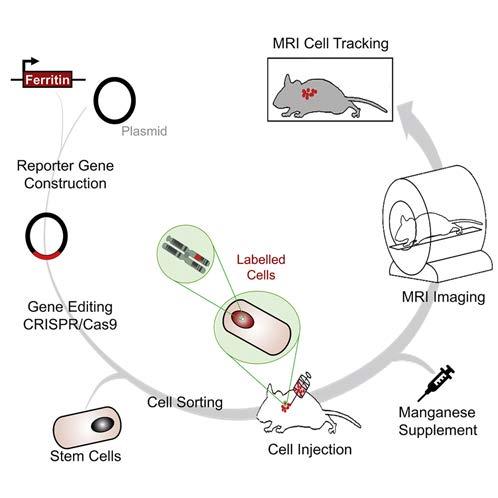
NFRF funding to move into human stem cells now that its efficacy has been proven in animals, focusing on the heart, brain, liver and cartilage.
High spatial resolution makes the imaging of small cell clusters possible, as well as the ability to track where cells migrate in the body. And the power of MR is its ability to provide a finer scale, more detailed image, since the pixels can be made very small. “In animal imaging, I would typically go down to 200 microns by 200 microns over a one-millimetre-slice thickness,” Cheng explains. “If we think about that type of spatial resolution at the micro level, it’s much better than nuclear medicine, which is at the millimetre to centimetre level.” Although nuclear is a sensitive technology, it can’t finely localize things, which becomes problematic when navigating an injection of cells in tight spaces, such as the spinal cord or the brain. Being just a few millimetres off could mean targeting the wrong region and harming the patient. “Having high spatial resolution ability to finely, more precisely locate is important—and you get that from MR,” Cheng observes.
Although traditional cell tracking doesn’t typically use MR, a type of MR tracking technology that involves labelling cells outside the body with an iron oxide nanoparticle exists, but it has its limitations. “Iron oxide gives us a dark signal within the body, whereas our technology gives us a bright signal,” says Cheng, who uses manganese-ferritin
nanoparticles to form a bright contrast agent that makes it much easier to differentiate the target cells. The signal achieved with that brightness is specific to the cell population and not easily confused with other features in the body. By contrast, iron oxide labelling suffers the same limitation as other cell-labelling methods that occur outside of the body, in that only a certain amount of the label can be put into the cells—and as those cells divide and grow, the signal is lost. The traditional method of tracking cells in MR with iron oxide particles is not a viable method for long-term cell tracking, because when cells die, as many do in the immediate post-injection interval, the contrast label gets released by the dead cells. “Unfortunately, with iron oxides, macrophages and all these phagocytic cells love to come in and eat them up. So, we’re detecting the dark signal, but it’s not coming from the target population,” Cheng explains. “It’s a false positive.”
In Cheng’s method, the signal doesn’t dilute and disappear as cells divide, and the technology can also achieve much deeper tissue penetration compared to other approaches. “We’re using a reporter gene system, which will enable cells to maintain the same signal intensity regardless of how many cell divisions the cell population goes through,” Cheng says. “This presents an opportunity we haven’t been able to achieve before for deep tissue cell tracking, in that we’re now able to track cells for as long as they’re alive without having to worry about the signal disappearing.”
Researchers at the Ted Rogers Centre for Heart Research have devised a method for isolating vital cells called endothelial cells that facilitates the genesis of engineered blood vessels. “Endothelial cells are the fundamental building blocks for vascular tissue engineering,” says Paul Santerre, PhD, LEL, principal investigator and U of T professor at the Institute of Biomedical Engineering (IBE). Tissue engineers face enormous challenges in the field, among them, ensuring newly engineered tissues receive adequate blood supply. “Engineered tissues that exceed the diffusion limit of oxygen and nutrients through tissues are at risk of starvation, necrosis and,

“THIS PRESENTS AN opportunity we haven’t been able to achieve before for deep tissue cell tracking, in that we’re now able to track cells for as long as they’re alive without having to worry about the signal disappearing.”
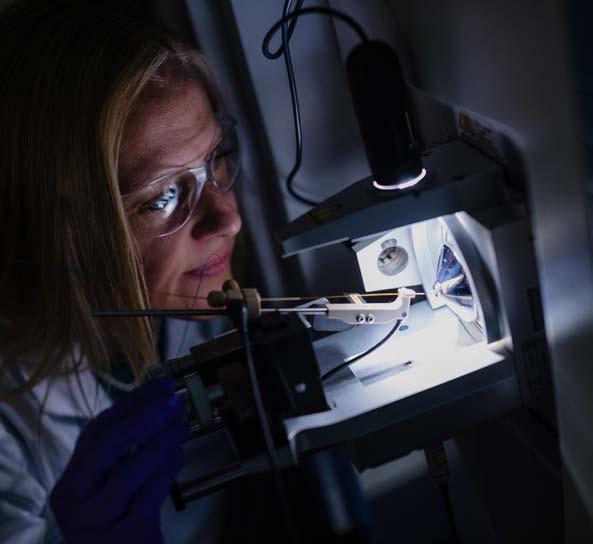
and contraction and play an important role in preventing blood from clotting, as well as regulating the delivery of oxygen and nutrients to tissues in the body. They’re also in short supply. But the team identified an abundant source— one that is routinely discarded as medical waste. “The answer was fat,” Antonyshyn says. “It’s abundant, it’s accessible and it’s dispensable. This means we can harvest large quantities of endothelial cells for vascular tissue engineering in a patient-specific manner without extensive manipulation of the cells nor extensive morbidity for the patient.”
ultimately, resorption by the body,” Santerre explains. “The long-term survival and function of these implants requires the sustained delivery of oxygen and nutrients, which can be achieved by installing networks of blood vessels within the engineered tissue.” The team published their findings from a 2021 study in Nature’s Communication Biology Santerre, who is also the Baxter chair in health technology and commercialization for the University Health Network, notes that although tremendous progress has already been made in engineering functional blood vessels, the endothelial cells are rarely transferrable to the clinic. This is because the cells are predominantly sourced from a donor, cannot be isolated in high enough quantity in a timely and reliable manner and concerns have been raised by their extensive manipulation and resulting behaviour, as in the case of stem cells. “We sought to identify a source of endothelial cells that could be translated to the clinic with minimal concerns over their safety and efficacy,” says Jeremy Antonyshyn, study first author and graduate student researcher at IBE. In fact, securing these cells from patients to use later is extremely rare, and until now, the use of endothelial cells in tissue engineering has been primarily confined to animal models.
Endothelial cells make up the endothelium, a thin membrane that lines the inside of the heart and blood vessels. Critical to their function, they act as a barrier to contain the flow of blood within the vessels, control vascular relaxation
By harvesting endothelial cells from a patient’s own fat, clinicians and tissue engineering experts can build blood vessels that would not be seen as foreign by the body, eliminating the need to suppress the patient’s immune system. This is critical. Medications that suppress the immune system are needed to prevent the rejection of cells that are foreign to a patient’s body, such as those from a donor. And although the medications are effective, they also suppress the ability of the immune system to fight off diseases and infections, such as COVID-19 and cancers. “This is a major source of morbidity and mortality for patients,” Antonyshyn explains. “Rather, these engineered constructs would be tolerated by the patient’s immune system since, they are made of the patient’s own cells, circumventing the need for immunosuppressive therapies and its adverse side effects.”
However, the isolation of endothelial cells from tissues is extremely challenging. “They are often contaminated and overgrown by other cell types, undermining their utility for vascular tissue engineering,” Antonyshyn points out. “We studied the underlying challenges to develop a reliable method of acquiring endothelial cells in large quantity and high purity.” Their method adapts a well-established technique, magnet-assisted cell sorting, to isolate endothelial cells from fat. This technique generally employs superparamagnetic particles on the micro scale—less than 5 µm in diameter—coupled to antibodies to selectively extract cells based on their unique cell-surface protein signatures. “We observed that the antibodies were not the only factor affect-
“THE TRANSPORT OF BLOOD is fundamental to tissue engineering—and with this technology, we can do so without the need for immunosuppressive therapies.”
ing the affinity of the particles to the cells—their size and the nature of their exposure to the cells were critically important too,” Antonyshyn explains. The use of lesser-sized particles resulted in their non-discriminant uptake by nonendothelial cells and became an engineering process problem—as the smaller the particle, the faster this uptake would occur. By defining the minimum particle size needed to prevent their non-discriminant uptake to be 5 µm and by regulating their exposure to the cells, they were able to reproducibly acquire endothelial cells from patients with purities greater than 98 per cent, which is sufficient to enable their use for vascular tissue engineering.
The ability to harvest endothelial cells from a patient’s own fat is an enabling technology. The global tissue engineering market is expected to reach US$28.9 billion by 2027, expanding at a compound annual growth rate of 14.2 per cent, according to a report by market research firm Grand View Research. “Our method of isolating endothelial cells may be used to develop small diameter vascular prostheses for surgical bypass procedures, through to the vascularization of engineered organs for transplantation—gingival tissues in the oral cavity and vital heart tissues, for example,” Santerre explains. “The transport of blood is fundamental to tissue engineering—and with this technology, we can do so without the need for immunosuppressive therapies.”
A major medical milestone was marked on November 14, 2021—the 100year anniversary of the discovery of insulin by U of T researchers Frederick Banting, MD, and assistant Charles Best. Although their discovery saved countless lives, treatment requires those living with diabetes to inject insulin several times a day to control their blood sugar. They must also measure blood sugar regularly to determine how much insulin they need and when they need it—a process that is a normal function of the pancreas in healthy individuals. And if glucose testing is not performed regularly and assessed correctly, it can result in life-threatening consequences. Indeed, those living with diabetes endure a multitude of serious health issues, ranging from vascular and kidney disease to blindness and the loss of limbs. The goal is to find a cure, and researchers have been rigorously exploring methods to end the need for daily injections—including an innovative under-skin cell therapy for Type 1 diabetes that’s being developed at the very institution insulin was discovered a century earlier.
One goal of the research community is to transplant the cells in the pancreas that produce insulin and detect glucose—beta cells that sit within a pancreatic islet structure, which is an aggregate of cells inside the pancreas. “Diabetes is an autoimmune disease,” explains Michael Sefton, ScD, P.Eng.
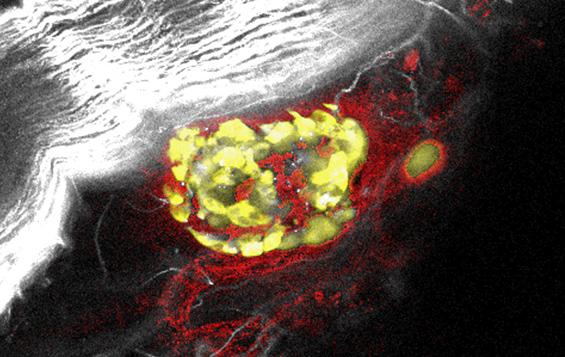
Michael Sefton’s lab has advanced a cell-based treatment for Type 1 diabetes that involves transplanting pancreas islets (in yellow) under the skin and may eliminate the need for insulin injections.
“In a person with diabetes, those islets stop working because they’ve been attacked by their own immune system—and we’re trying to restore the function after the islets have been destroyed.” Sefton, who’s been involved with diabetes research since returning to the university in the ‘70s, when he worked on a concept for an insulin pump, is a professor at U of T’s IBE and the department of chemical engineering and applied chemistry. Sefton runs a lab at the Terrence Donnelly Centre for Cellular and Biomolecular Research, and he is also the executive director of Medicine by Design, an incubator for transformative research in regenerative medicine and cell therapy. From the early days of his research, Sefton knew the real problem was creating a way for the body to replace the missing glucose-sensing function— the work of beta cells. His team is developing ways to transplant these cells under the skin.
“Since the Edmonton Protocol was devised in 2000, people have been trying to learn how to isolate whole islets,” Sefton explains. The Edmonton Protocol is a procedure that enables clinical islet transplantation; although up to 80 per cent of recipients may not need additional insulin for the first year after transplant, many must return to using insulin over time. According to Sefton, transplanting human pancreas islets into the liver makes good physiological sense. But by doing that, about 60 percent of the islets are destroyed. This means many more islets are needed than are readily available. One solution is to use stem cells to generate an unlimited supply of insulin-producing cells—an approach some have begun to make work. What Sefton’s team is trying to accomplish, instead of delivering the islets—or stem cell–derived insulin-producing cells—into the liver, is to put them under the skin. “The skin is more accessible for putting things in. It’s a simple injection,” Sefton observes. “And maybe more importantly, it’s a simple retrieval process. You don’t have to remove part of the liver if you want to stop therapy.” When working with stem cells, safety is a primary concern. “You want an exit strategy,” Sefton says.
The skin is a much safer place to put the cells, but the skin needs to be prepared to make that happen—and that’s where Sefton’s team comes in. “We have discovered a material
that causes blood vessels to grow by magic,” muses Sefton, whose earlier research focused on a biocompatible polymer, known as HEMA-MMA. The polymer, which is permeable to glucose and other nutrients, allows the cells to remain viable and function normally. And since the membrane is impermeable to antibodies, which have a higher molecular weight, the cells are not rejected when implanted. In the course of that work, Sefton’s lab discovered that methacrylic acid caused blood vessels to grow and learned how to make an injectable material from it. “We can put pancreatic islets in the liquid and inject it and the islets under the skin,” Sefton explains. “And, at least in mice, those islets, those insulin-secreting cells, are able to keep blood sugars normal— effectively reversing the diabetes we induced in the first place.” The formation of blood vessels is crucial to the delivery of insulin. Without them, the islets don’t survive. And as a result, insulin is not produced.
Sefton’s team solved the problem of vascularization, but their next step is to control the immune response. “We have blood vessels. We have surviving islets—but we still have an autoimmune problem,” Sefton observes. There is a critical question to solve, he points out: What is the diabetes of the individual doing to the transplanted cells? Next, Sefton and his team will determine if they can use the same gel to deliver islets—and a second cell called a dendritic cell—and induce tolerance to the islets, so the subject will not mount an immune response. The team recently received funding from the Juvenile Diabetes Research Foundation to pursue this critical line of thought. e
SEFTON’S TEAM solved the problem of vascularization, but their next step is to control the immune response.

Professor Andrew Sowinski, PhD, P.Eng., designed a fourth-year capstone course that allows students to apply chemical engineering principles through hands-on craft beer-making.
A University of Ottawa (uOttawa) chemical engineering professor is hoping that the opening of a student-run microbrewery on campus will help his undergraduate students gain practical hands-on engineering experience.
Andrew Sowinski, PhD, P.Eng., assistant professor of chemical and biological engineering at uOttawa’s faculty of engineering, was inspired by the uOttawa Richard L’Abbé Makerspace and the Manufacturing Training Centre, two spaces at the engineering faculty’s Centre for Entrepreneurship and Engineering Design that allow students to test and prototype designs. “The Makerspace has laser cutters, 3D printers and a place where students can learn how to use lathes and mills and welding,” Sowinski explains. “But as a chemical engineer, I was looking at this and saying, ‘This is great, but chemical engineering is a process, and usually you have to do something that fits on a table.’” In November 2019, Sowinski
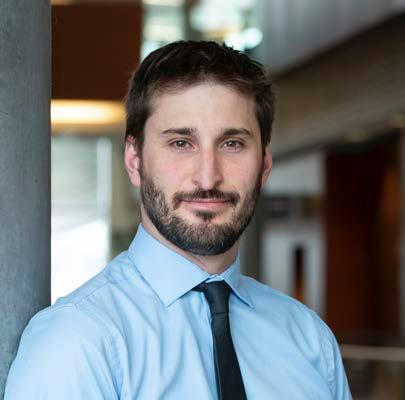
By Adam Sidsworth
approached Jacques Beauvais, PhD, ing., dean of the faculty of engineering at uOttawa, and they brainstormed a suitable space for chemical engineering students. “I thought about a microbrewery or a craft distillery, which is where the Craft Lab came in.”
The process of making beer is essentially a series of chemical engineering tasks that include separation processes and biochemical reactions. For Sowinski’s plan design course, students would apply their chemical engineering knowledge to design a microbrewery on campus and produce beer at scale. Sowinski first put out a call for students to participate in the brewery project during the winter 2020 session, and to his surprise, Sowinski had seven groups of chemical engineering students enthusiastically wanting to participate. Sowinski had the student groups write business proposals and explain why their group was suited for the project, but because of its initial popularity, Sowinski’s solution was to propose a second project—an opportunity to participate in distilling vodka.
THE PROCESS OF MAKING BEER IS ESSENTIALLY A SERIES OF CHEMICAL ENGINEERING TASKS THAT INCLUDE SEPARATION PROCESSES AND BIOCHEMICAL REACTIONS. FOR SOWINSKI’S PLAN DESIGN COURSE, STUDENTS WOULD APPLY THEIR CHEMICAL ENGINEERING KNOWLEDGE TO DESIGN A MICROBREWERY ON CAMPUS AND PRODUCE BEER AT SCALE.
“What I love about the project is that we haven’t even built [the brewery] yet, and I asked the students, ‘What do you want to look at?’ I had a student who really liked the instrumentation and how we can make it go online. Another student said, ‘I noticed that the spent grain goes down the drain,’ so he was looking to see if we could make biodegradable cups out of it,” Sowinski explains. “The students are coming in with ideas and going out with projects. Right now, it’s still theoretical until we build [the brewery], but this is the starting point.”
To obtain hands-on experience prior to building the campus brewery, the student teams are being partnered with local breweries and distilleries. During the Craft Lab’s first year, Nora Wong was a fourth-year chemical engineering and biochemistry student leading the distillery team, which worked collaboratively with Top Shelf Distillers in nearby
Perth, ON. “They explained their distillation and fermentation process,” Wong notes. “They really helped to drive our design ideas. We got to get a feel for what it was like to work in the industry.”
Wong’s team was tasked with designing a distillation process for a vodka they could theoretically distil, and working at Top Shelf helped Wong make industry-specific connections with the chemical engineering theories she had been learning about in class. “One of the classes we take is unit operations, so each person in our group had to design a specific unit for the [distillation] process,” Wong explains. “One of them was the fermentation vessel—you have to apply the kinetics of the enzymes and yeast to the process. You’re looking at the biological side from our biotechnology class, as well as things like fluid flow or mixing or heat transfer so we can understand when enzymes and yeast give off heat.”
Indeed, Wong’s undergraduate thesis, which explored using microalgae to capture carbon dioxide from the fermentation process, grew out of her experience at Top Shelf. Her experience also led to an opportunity to complete a co-op placement at Labatt, where she was able to collaborate with the large brewer’s engineers. “It helped me realize how much I like this sort of diverse teamwork and problem solving, which led me to pursue a career in consulting.”
AMERICAN PALE ALE IS A HIT ON CAMPUS
Kiefer Galliford and Jade Breau, both fourthyear chemical engineering students, are co-leading this year’s brewery team, which is partnering with microbrewery Flora Hall Brewing in downtown Ottawa. Flora Hall is helping Galliford more readily grasp the chemical engineering concepts he has studied. “If I see things, I [better] understand how they operate,” Galliford explains. “It makes it easier to apply those mathematical formulas and to see how heat flows. I can look at a tank now and see how the heat is dissipating throughout.”

Galliford is also appreciative of the leadership skills he’s developed by collaborating with the other students and Flora Hall staff. “I’ve had the opportunity to help lead the team and work with groups to help them get a better understanding of engineering and how things are applied outside the classroom,” Galliford notes. Breau concurs, noting, “Students experience the technical side of engineering and also how to run a business, problem solve and collaborate in a large team.”
This past November, Galliford and the team were able to brew approximately 14 hectolitres of American pale ale at
Flora Hall’s facility. “We had the students work as brewers to create the beer,” Galliford observes. “We had them measuring the grain; they were plotting and taking samples; they were involved with the whole process. The beer was sold from Flora Hall, but we made a large purchase to distribute to other faculties and alumni to create noise about the project. It was received very well. Flora Hall sold out within 20 to 25 days.”
Galliford notes that the team is currently looking at developing a small-scale brewery system to get more students familiarized with the brewing process, with the ultimate goal of opening the student-run brewery on campus as Sowinski originally envisioned. However, COVID-related supply issues have pushed up prices and hindered the opening of the facility in the short term. “You have to find the space that can also operate as a brewery,” Galliford says. “You have to have drainage; you have to have ventilation; you have to be able to have steam. Now we have to raise this much more money.”
The uOttawa’s faculty of engineering and the Craft Lab students currently have an online campaign to fundraise an additional $10,000 to open an on-campus facility. Remarkably, the fundraising efforts by students, the faculty and wider uOttawa community have already raised nearly $100,000.
For Sowinski, the Craft Lab is part of a new trend in engineering education that combines the best of classroom education and practical experience. For uOttawa, this evolution is happening within the newly founded School of Engineering Design and Teaching Innovation (SEDTI).
“We’re trying to create better engineering education and better engineering experiences. We’re designing courses with the experiences of going out and working with industry,” Sowinski notes. “What the students did at Flora Hall was prototype a course on experiential learning. They could go in and work and come back and meet with other students and explain what they learned to build not just technical knowledge but a breadth of what an engineer does.” e
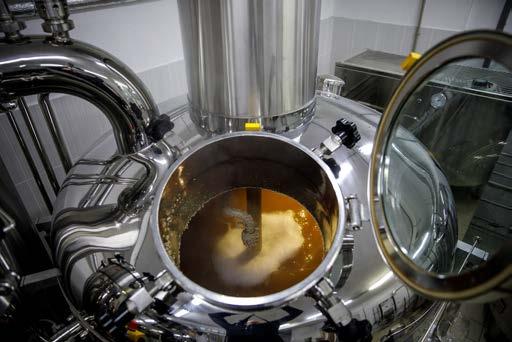


Date: April 30, 2022
Time: 10 a.m. EDT
Location:
Webcast information will be posted on PEO’s website.
In accordance with section 20 of By-Law No. 1, which relates to the administrative affairs of PEO, the 2022 Annual General Meeting (AGM) of the Association of Professional Engineers of Ontario will be held on Saturday, April 30, 2022, at 10 a.m.
As noted in section 17 of By-Law No. 1, the AGM of PEO is held for the following purposes:
• To lay before licence holders the reports of the Council and committees of the association;
• To inform licence holders of matters relating to the affairs of the association; and
• To ascertain the views of the licence holders present at the meeting on matters relating to the affairs of the association.
PEO’s AGM will be held using a virtual meeting format. This means proceedings will be conducted solely via live webcast. The meeting will be in listen mode only. Licence holders will have the opportunity to submit questions online during the meeting and provide submissions in advance. Licence holders interested in participating in the meeting, including voting on business properly brought before the meeting, will need access to an internet-connected device for the full duration of the meeting.
Licence holders wanting to attend the meeting must preregister online. To register with voting status, licence holders must register using their name, email address and licence
number that is registered with PEO. Registration closes on April 28 at 9 a.m. If you have not provided an email address to PEO, please do so by April 20 through PEO’s online portal
Licence holders can make submissions on matters of importance to the work of PEO. Submissions must be received by April 20. To make a submission, use the template in the Guide for Member Submissions. Submissions received after this time will not be considered at the AGM. Once received, submissions will be posted on PEO’s website.
Because the AGM will be conducted in listen mode only, licence holders making submissions are being given the opportunity to pre-record a brief introduction to their submission. Those making submissions can produce their own video recording, which will be played during the meeting. Details on the technical requirements for the recording can be found in the Guide for Member Submissions
PEO President Christian Bellini, P.Eng., FEC, will preside and present his report to the AGM. President-elect Nick Colucci, P.Eng., FEC, and CEO/Registrar Johnny Zuccon, P.Eng., FEC, will also provide remarks. The president-elect, officers and councillors for the 2022–2023 term will officially take office at the conclusion of the meeting.
PEO often receives questions about the requirements for sealing 3D CAD models issued to clients and what to do if the models contain proprietary design information. Here’s what professional engineers need to know.
By José Vera, P.Eng., MEPP
Consider this scenario: Leylah, a professional engineer, has been asked by her supervisor to send a client a 3D computer-aided design (CAD) model, which the client will use to print engineered machinery components in their industrial 3D printer. Leylah is uncertain if she should seal the 3D CAD model. In the past, Leylah had issued to the same client final sealed 2D PDF drawings. However, in this case she is not sure if a 3D CAD model must also be sealed, and she does not know how a seal, which is 2D, could be applied to a 3D model.
In situations like these, PEO’s practice advisory team refers practitioners to PEO’s Use of the Professional Engineer’s Seal practice guideline, which indicates that practitioners must seal engineering documents. There are some exceptions, such as draft or incomplete documents, which should not be sealed. The guideline indicates that engineering documents, including electronic formats, that are not used solely for internal purposes must be sealed.
After reading the PEO guideline, Leylah realizes that 3D CAD models issued outside of her organization and that contain engineering content must be sealed to comply with section 53 of Regulation 941 of the Professional Engineers Act However, sometimes 3D models by themselves do not have engineering content. For example, the G-code of a bracket simply contains instructions for a 3D printer to produce the bracket and may not need to be sealed, since the context is not there to make it an engineering document. However, there is often a specification written by a professional engineer with specific instructions on how the models should be printed, finished and assembled, and this specification must be sealed since it contains engineering instructions, as noted in the PEO guideline.
Leylah concludes that, in her case, the 3D CAD model sent to the client must be sealed, since the model contains engineering content, such as materials specifications, dimensional tolerances and manufacturing instructions. However, she is still not sure how to apply a 2D seal to a 3D model, so she contacts PEO’s practice advisory team.
Every leading professional 3D CAD software today has a document management system that includes
a digital approvals process. Although the models themselves might not be able to be sealed, a PDF specification linked to the models could be approved and sealed electronically by the professional engineer(s) assuming responsibility for the work. This digital process could be used to follow the requirements set out in section 53 of Regulation 941 and described in PEO’s guideline. For example, if the practitioner is using the Onshape system, he or she can specify approvers.
Other CAD software, such as AutoDesk, Bentley Systems, Dassault Systèmes and Siemens, have similar digital approvals processes. Building information modeling (BIM) software packages also have a digital approvals process that could be used to comply with the use-of-seal requirements. Additionally, finite element analysis (FEA) models themselves are not typically sealed; however, the engineering analysis reports that refer to the FEA models are. For more information, refer to PEO’s Professional Engineers Using Software-Based Engineering Tools guideline, specifically:
7. Issues Related to Software-Derived Information
Output from computer programs, like all working notes and calculations, are usually the property of the engineer (his, her or their employer) and generally do not need to be provided to the client or submitted as part of regulatory approval processes unless required by law or contract. In those cases where output data must be supplied to people outside the organization employing the practitioner, the data should be distributed either as hard copies or electronic files bearing the seal and signature of the professional engineers who prepared or supervised the preparation of the input data and checked the output data…
WHILE ALL DOCUMENTS CONTAINING ENGINEERING CONTENT, INCLUDING ELECTRONIC, GENERALLY MUST BE SEALED, PRACTITIONERS SHOULD ASK THEMSELVES IF THEIR NATIVE 3D CAD MODELS CONTAIN PROPRIETARY DESIGN INFORMATION THAT SHOULDN’T BEING SHARED.
PROPERTY
When Leylah contacts PEO’s practice advisory team, a practice advisor raises the possibility that the 3D CAD model, which Leylah would be sealing and issuing to the client, might contain engineering design information that is proprietary to ABC Engineering, Leylah’s employer. The practice advisor suggests that Leylah discuss this issue with her management team and possibly their legal counsel to ensure proprietary design information is not being shared invertedly with

the client. So, Leylah schedules a meeting with ABC’s management and legal counsel. At the meeting, they agree that the best option is to remove any proprietary design information from the 3D CAD model before sharing it with the client. Management recommends to Leylah that she collaborate with the CAD administrator and IT to find a workable solution.
Leylah, the CAD administrator and IT conclude it’s best not to share the original native 3D CAD model, since it contains proprietary design information. They decide to share a neutral 3D CAD file, such as Standard for the Exchange of Product (STEP) model data, instead. Together they determine the best option is to export and share a STEP file with the client, accompanied with an electronically sealed PDF of an engineering specification, which allows the client to print the machinery components on their industrial 3D printer but does not contain any proprietary engineering design information.
PEO’s practice advisory team often receives questions from practitioners wondering if they must seal 3D CAD models issued to clients. Although all documents containing engineering content, including electronic, generally must be sealed, practitioners should ask themselves if their native 3D CAD models contain proprietary design information that shouldn’t being shared. If that is the case, there are alternative neutral 3D
CAD formats that can remove proprietary design information and be used instead. Practitioners can contact their IT department and CAD administrator for more detailed technical information on this subject.
There are also cases when an engineering firm is engaged to provide native 3D CAD models to a client; for example, if the design is the intellectual property of the client. Consequently, practitioners may need to consult with their management team and their firm’s legal counsel to address potential intellectual property issues before sharing 3D CAD models outside of their organization.
For further questions on the use of the seal and the obligations of professional engineers, please visit PEO’s practice guidelines webpage. For questions on these guidelines, contact PEO’s practice advisory team at practice-standards@peo.on.ca e
José Vera, P.Eng., MEPP, is PEO’s manager of standards and practice.
MARCH 25
TInternational Conference on Recent Advances in Engineering and Technology, Ottawa, ON
TMARCH 27–28
International Conference on Chemical and Biochemical Engineering, Ottawa, ON
APRIL 26
The following events may have an in-person and/or online component. See individual websites for details.

MARCH 26–27
MARCH 26
International Conference on Electrical Machines and Systems, Toronto, ON
International Conference on Science, Technology, Engineering and Management, Hamilton, ON
MARCH 27–28

TInternational Conference on Electrical, Electronics, Communication and Robotics Engineering, Toronto, ON

APRIL 28-29
TTInternational Conference on Heat Transfer and Fluid Flow, Toronto, ON
International Conference on Medical and Biosciences, Ottawa, ON
APRIL 26–27
International Conference on Robotics, Aeronautics, Mechanics and Mechatronics, Ottawa, ON
APRIL 30
PEO Annual General Meeting (virtual only)
Deep Medicine: How Artificial Intelligence Can Make Healthcare Human Again, by Eric Topol, MD, 2019: A look at how AI will empower physicians and revolutionize patient care
The Code Breaker: Jennifer Doudna, Gene Editing, and the Future of the Human Race, by Walter Isaacson, 2021: An account of how Nobel Prize winner Jennifer Doudna, PhD, and her colleagues invented an easy-to-use tool that can edit DNA
Nanophotonics in Biomedical Engineering, by Xiangwei Zhao, PhD, 2021: A summary of the latest advances in nanophotonics for biomedical applications
Speaking of Science
A podcast from the Intramural Research Program of the National Institutes of Health, known for its synergistic approach to biomedical science
The New England Journal of Medicine Interviews
A weekly general medical journal about new medical research findings, review articles and editorial opinions on a variety of biomedical science and clinical practice topics
eLife Podcast
A podcast from eLife, the researcher-led, open-access digital publication for outstanding research in life science and biomedicine
Is This the Future of Health?
Artificial intelligence is already shaping the world, from driverless cars to dating, but its greatest impact will be on people’s health.
Genetic Engineering Will Change Everything Forever–CRISPR
Designer humans, the end of disease, genetically modified people that never age—what used to be science fiction is becoming reality.
How AI is making it easier to diagnose disease
What if we could drastically reduce the amount of data needed to train an AI, making diagnoses lower cost and more effective?
Compound Microscopes
An overview of microscopes, from their beginnings through to working principles, components and the varying types used in the medical field
By Nicole Axworthy
545TH MEETING, FEBRUARY 18, 2022
At its February meeting, Council approved a Preliminary Regulatory Impact Assessment (PRIA) and accompanying appendices for the creation of a mandatory continuing professional development (CPD) program. The PRIA will be submitted to the Ministry of the Attorney General to proceed with drafting the necessary amendments to Regulation 941 to facilitate the implementation of a mandatory CPD program. This is the first step in the process of ensuring that PEO has the necessary legal framework to require and enforce mandatory compliance.
As indicated in previous Council motions, PEO is preparing to implement a mandatory CPD program based on its voluntary Professional Evaluation and Knowledge (PEAK) program. It will be a mandatory annual component of licensure for all PEO-licensed engineers, beginning in January 2023 (see p. 9). The power to create regulations that govern the continuing education of members is authorized by section 7(1)(27) of the Professional Engineers Act (PEA). However, new subsections in Regulation 941 are necessary to enforce licence holder participation and to allow the registrar to apply sanctions for non-compliance.
Once the PRIA is submitted to the attorney general, PEO staff will work with the ministry to refine the regulation changes to match the policy intent of the PRIA. They will also be submitted to Council for final approval before being sent to Cabinet for proclamation in advance of the mandatory program launch next year.
Council passed a motion to seek operational and procedural improvements to the PEA. Council approved submitting a request to the Ministry of the Attorney General to amend the PEA to support the mandatory annual reporting and audits for the upcoming mandatory CPD program; to be able to provide electronic delivery of all notices and communications from PEO to holders of licences, designations and certificates of authorization; and to streamline the timeline for complaints.
The submission is requesting changes to the wording of specific sections of the PEA that are necessary to support operational efficiency and transparency and help PEO continue to modernize its regulatory operations. For the mandatory CPD updates, the PEA currently only imposes certain requirements for licence and certificate holders to update information that PEO’s register already contains but does not require annual reporting. The update broadens what can be required in terms of providing initial information, annual reporting and register updating. For electronic delivery of communications to licence holders, the act
currently specifies mail as the means for delivery of PEO communication, which is outdated—a point which the COVID-19 pandemic underscored. The update will change the wording so that “deliver” includes all possible methods of delivery and provides flexibility as technology advances. And for complaints timelines, the proposed change will eliminate a cumbersome procedural step in PEO’s complaints process and avoid delays associated with the current process without altering the result of PEO’s investigation process.
In accordance with PEO’s act change protocol, PEO staff will send the policy intent to the attorney general for policy approval followed by legal drafting, Cabinet review and, at the government’s discretion, inclusion in future proposed legislative change opportunities through the Legislative Assembly and forthcoming proclamation.
THE ACT CURRENTLY SPECIFIES MAIL AS THE MEANS FOR DELIVERY OF PEO COMMUNICATION, WHICH IS OUTDATED—A POINT WHICH THE COVID-19 PANDEMIC UNDERSCORED.
With the term ending for one of PEO’s current directors on the Engineers Canada board, Council voted on a new director to represent PEO on the board. Christian Bellini, P.Eng., FEC, was nominated for a three-year term effective as of the Engineers Canada annual general meeting on May 28. Bellini will take over for current PEO representative Kelly Reid, P.Eng., whose term ends on May 28.
Engineers Canada’s board is composed of 23 directors who are nominated by their engineering regulators across Canada and approved by all the regulators at the organization’s annual meeting. Bellini will join four current PEO representatives on the board who include Arjan Arenja, P.Eng., Nancy Hill, P.Eng., FEC, LLB, and Marisa Sterling, P.Eng., FEC; and Engineers Canada’s current president is PEO-licensed professional engineer Danny Chui, P.Eng., FEC.
Council approved publication of the Use of the Professional Engineer’s Seal guideline, which was updated following the recent approval of Regulation 941 changes related to the use of the professional engineer’s seal.
At its September 26, 2016, meeting, Council instructed the Professional Standards Committee (PSC) to create a subcommittee to revise the existing guideline and its requirements in Regulation 941. And at its meeting on November 19, 2021, Council passed a related motion approving amendments to Regulation 941 to clarify use-of-seal requirements. The updated Use of the Professional Engineer’s Seal guideline reflects the regulation amendments, which will come into effect on July 1. In addition to the information on the amendments that clarify the use-of-seal requirements, the guideline update also addresses issues involving the seal and new technologies, such as digital files that eliminate the need for conventional two-dimensional drawings.
As part of PEO’s process for creating a practice guideline, draft documents of the updated Use of the Professional Engineer’s Seal guideline were posted on PEO’s website for licence holder and stakeholder consultation from August to October 2021; and relevant stakeholders, such as the Association of Consulting Engineering Companies–Ontario, Engineers Canada, Ontario Society of Professional Engineers and several government ministries, were directly invited to the public consultation. The draft document was revised as required based on recommendations following the consultation before being reviewed by the PSC and the Regulatory Policy and Legislation Committee. Now that the guideline has been approved by Council, it will be prepared for publication and then posted under the Knowledge Centre of PEO’s website.
At its February meeting, Council approved a motion related to Phase 4 of the Governance Roadmap that will see the
continuation of PEO chapters as currently referenced in the regulations and bylaws of the association. Council also endorsed a process recommendation by the Governance and Nominating Committee (GNC) to deal with the activities and outputs of chapters, along with all other activities and outputs that are in the “neither” category (not considered governance or regulatory) of the activity filter. As part of the motion, Council also directed the GNC to oversee a risk assessment, which includes consultation with chapters, with a view to eliminating “high risk” activities and operationalizing others so that volunteer engagement is maintained, and more effective organizational control is ensured. GNC is expected to bring recommendations for these activities to a future Council meeting for decision.
PEO created and applied an activity filter to all its activities and outputs as part of a high-level action plan and following recommendations from its external regulatory review in 2019. The activity filter helped determine which of PEO’s activities and outputs fit under its regulatory or governance responsibilities or had neither a regulatory nor governance purpose. The application of the activity filter suggested that PEO chapters and their related activities were considered neither regulatory nor governance. GNC has proposed that all activities that fall under the “neither” category be addressed based on their legal, financial or reputational risk. The committee will develop a workplan and it is anticipated that an update will be provided to Council before this year’s annual general meeting in April. e
As part of our commitment to modernizing our operations, we will soon be implementing a change in how we deliver information to you.
Effective April 30, 2022, all applicants and licence and certificate holders will be required to provide PEO with a valid and unique (i.e. not shared) email address to receive regulatory communications from us. This includes renewal notices, Council elections materials, annual general meeting details, updates on our Practice Evaluation and Knowledge program and changes to provincial legislation, regulations and PEO bylaws. After this date, we will no longer be using regular mail to communicate with applicants and licence and certificate holders.
To provide us with your email address, simply log in to the PEO portal at secure.peo.on.ca and update your contact information under the Profile tab. Then, make sure to add PEO to your approved senders list (@peo.on.ca) so our email messages don’t end up in your spam filter.
Thank you for your co-operation as we continue to improve and streamline our operations to serve you more efficiently.




Engineered control valve technologies for all control requirements



www.lexcanada.com jlane@lexcanada.com
| samson.ca@samsongroupna.com www.samsongroup.com
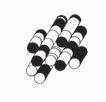
roofing, shoring design, retaining wall design Brampton Barrie Sudbury Stoney Creek (905) 796-2650 (705) 739-8355 (705) 670-0460 (905) 643-7560 www.terraprobe.ca

Enbridge enbridgesmartsavings.com/business Manulife Bank manulifeone.ca/engineerscanada SAMSON Group samsongroup.com
AD INQUIRIES Your business card here will reach 80,000 professional engineers. Contact: Dovetail Communications, Charlene Woron, 905-707-3509, cworon@dvtail.com; Leesa Nacht, 905-707-3521, lnacht@dvtail.com Deadline for May/June 2022 is April 7, 2022. Deadline for July/August 2022 is June
AD INQUIRIES Your business card here will reach 80,000 professional engineers. 905-886-6640, ext. 306, fax: 905-886-6615, bkukkonen@dvtail.com
for March/April is January 23, 2020. Deadline for May/June is March
Dave Watson, P.Eng., Toronto ON
I have been receiving the hardcopy version. I have cut out and saved any articles I find of interest. Given you’re changing to only the digital version being sent out, is there an ability to save such from this process, to save storage space? Alternatively, does each article have a web address, or are you keeping an accessible yearly summary, to enable members to find an article they remember?
EDITOR’S NOTE Our digital edition offers many functions, including the ability to share content on social media, email the issue to friends and colleagues, search for articles using keywords and download a PDF to your computer or other electronic device. Additionally, readers can access the current issue as well as all archived issues of Engineering Dimensions at anytime at engineeringdimensions.ca
The recent President’s Message, “Fairness in regulation” (Engineering Dimensions, January/February 2022, p. 6), rankled me in a way that I am sure impacted author Ayn Rand. Her central concept in Atlas Shrugged was the notion that expertise isn’t fair and that everyone should get a turn regardless of expertise.
I agree that there is a lack of fairness when it comes to internationally trained professionals. They have not had the benefit of experiencing the collaborative and team-based system of Canadian engineering universities; they have not experienced the iron ring process and ceremony that binds engineers; and they haven’t grown up in Canadian law. This puts them at a distinct disadvantage compared to those who have that experience.
My question then is: How is PEO going to impart that experience? PEO needs to step up and show leadership instead of reacting, unlike the issues with the BCIN regime or Elliot Lake, which cast a bad light on our profession because we did not lead.
“Professional” is not “Getting a turn because you are next.” That is for jumpy castles. “Making things easier” should not be the way, but rather “making sure” should be. A higher bar makes us all better.
LETTERS TO THE EDITOR are welcomed, but must be kept to no more than 500 words, and are subject to editing for length, clarity and style. Publication is at the editor’s discretion; unsigned letters will not be published. The ideas expressed do not necessarily reflect the opinions and policies of the association, nor does the association assume responsibility for the opinions expressed. Emailed letters should be sent with “Letter to the editor” in the subject line. All letters pertaining to a current PEO issue are also forwarded to the appropriate committee for information. Address letters to editor@peo.on.ca

PEO’s current voluntary PEAK program is transitioning to a mandatory program that will begin in January 2023. The program is designed to help licence holders maintain their professional knowledge, skills and competence as engineers and is in keeping with PEO’s regulatory, public protection mandate as set out in the Professional Engineers Act.
As of January 2023, all licence holders (both practising and non-practising) must comply with the program. More information can be found at www.peopeak.ca .
NATIONAL VOLUNTEER WEEK
April 24–30, 2022

In honour of National Volunteer Week, PEO recognizes and thanks our volunteers, including those who serve on Council, committees and their subcommittees, task forces and the Government Liaison Program; and PEO chapter leaders and volunteers, as well as those who represent PEO on external boards and advisory groups and participate in chapter-sponsored programs.
THANK YOU.


